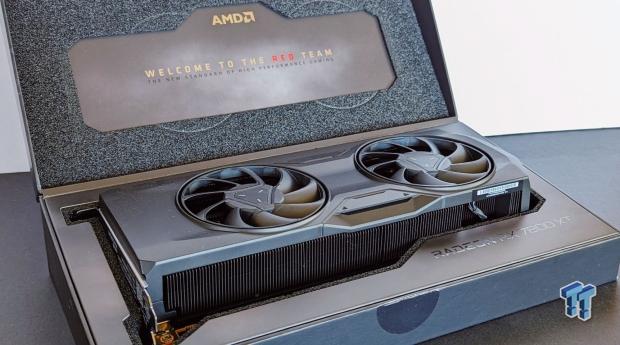
The Bottom Line
Pros
- + Excellent 1440p performance
- + Sturdy and compact for a high-end reference card
- + Competitively priced and great value
- + It gives the GeForce RTX 4070 a run for its money
- + Great value at USD 499 and free copy of Starfield
Cons
- - Ray tracing performance is a step behind the competition
- - The steep 4K performance drop-off
- - FSR 2 upscaling quality at 1440p
- - FSR 3 was not available to test as part of the review
Should you buy it?
AvoidConsiderShortlistBuyIntroduction
It took a while, but AMD's mid-range and enthusiast-level RDNA 3 offerings are here with the launch of the Radeon RX 7800 XT and Radeon RX 7700 XT. Both cards use the Navi 32 GPU, with varying specs, and like the flagship Radeon RX 7900 XT and 7900 XTX combo, feature a multi-chip design that combines a 5nm process for the GCD (Graphics Compute Die) and 6nm for the MCDs (Memory Cache Dies). It's something we haven't seen in the GPU space until the arrival of AMD's RDNA 3 generation and is now more widely available thanks to the competitive pricing for these two new graphics cards.
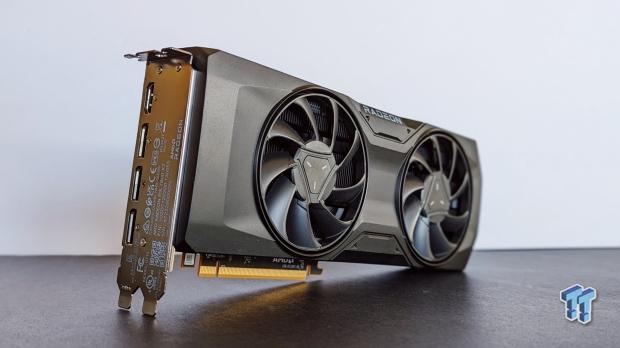
When it comes to the beefier Radeon RX 7800 XT (with this review covering AMD's reference design), in terms of performance, it's something of a letdown as a straight-up successor to the Radeon RX 6800 XT - in that you're simply looking at slightly better performance in a slightly more power efficient package. However, factor in the difference in launch price where the Radeon RX 6800 XT launched with an MSRP of USD 649, and the Radeon RX 7800 XT is hitting retail with an MSRP of USD 499. The story becomes more interesting and exciting, especially in the age of all-things-PC-related costing.
When AMD lifted the lid on the Radeon RX 7800 XT and 7700 XT at Gamescom, alongside giving some firm details on the long-awaited FSR 3, its internal performance metrics compared the Radeon RX 7800 XT to the GeForce RTX 4070 - a card that carries an MSRP of USD 599. So, even though the 7800 XT isn't delivering faster than last-gen flagship Radeon RX 6900 XT performance (like many hoped it would) - its direct competitor is not the GeForce RTX 4080.
Instead, we see AMD approach these two midrange and enthusiast-class GPUs from the price and performance perspective. And in many titles, the Radeon RX 7800 XT delivers notably better performance than the more expensive GeForce RTX 4070. There are some shortcomings; ray-tracing performance sees both cards struggle, FSR 2 at 1440p is not as impressive as DLSS, and FSR 3 is still a big question mark.
But, when viewed through the lens of 'what else is available at this price point,' the new Radeon RX 7800 XT could be one of the most popular GPUs amongst PC gamers in the coming months.

The RDNA 3 Generation
"The world's first chiplet gaming GPU" is how AMD described its new RDNA 3-based GPUs when it lifted the lid on the new Radeon RX 7000 Series. In layperson's terms, the GPU chip isn't just one big square or die anymore, with billions of transistors all arranged in a single layout. Like with its Ryzen CPU range, which embraced chiplet design to great effect (look at how Ryzen has grown in popularity over the years), bringing this design philosophy into the GPU space felt like the natural evolution for AMD's Radeon brand.
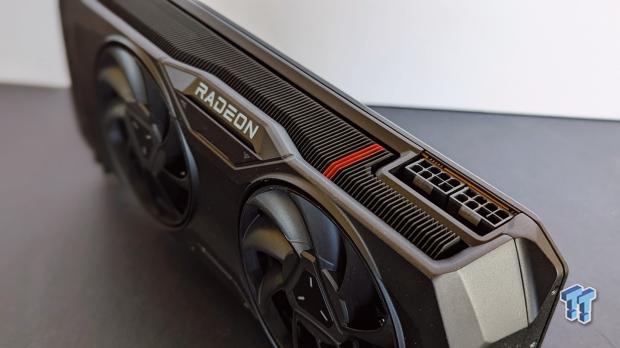
For RDNA 3, what was once a single Graphics Compute Die (GCD) has now split into a GCD plus a Memory Cache Die (MCD). The GCD still makes up most of the hardware grunt and uses the newer 5nm process technology - a step up from RDNA 2's 7nm process. Interestingly, the MCD uses 6nm process technology, which allows AMD to keep costs down as the complexity and cost of manufacturing high-end tech continue to rise.
And to mitigate any performance impact that could arise from going the chiplet route, AMD has also managed to include the "fastest chiplet interconnect in the world," with speeds of 5.3 TB/s. That said, the Radeon RX 7600 entry-level models using the 'Navi 33' GPU follow a more traditional single-chip setup using 6nm process technology to help keep costs down. But with the same RDNA 3 architecture.
AMD's groundbreaking chiplet design can be found in the 'Navi 32' and 'Navi 31' GPUs - Radeon RX 7700 XT, 7800 XT, 7900 XT, and 7900 XTX. AMD's RDNA 3 architecture also features second-generation AMD Infinity Cache, another CPU-like feature designed to boost performance in 1440p and 4K gaming - a "bandwidth amplifier" that sits alongside the GDDR6 memory interface. It helps alleviate the need for more expensive and power-hungry memory buses and is one of those forward-thinking designs we love seeing.
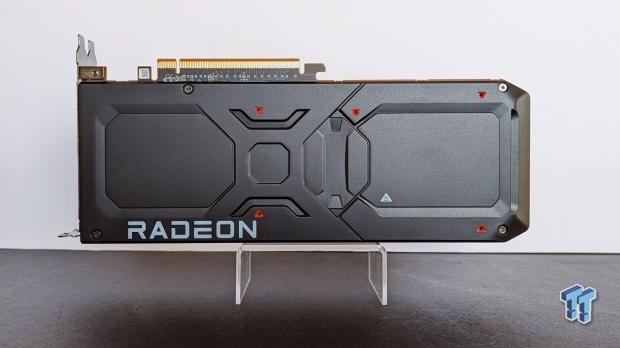
RDNA 3 also represents a significant leap forward for AMD regarding ray-tracing and AI accelerators. RDNA 3 GPUs feature the second generation of dedicated RT hardware and new hardware-based AI acceleration. Real-time ray tracing is hardware intensive; this is one area many were looking for AMD to improve compared to RDNA 2. Which, admittedly, was the company's first attempt at hardware-based ray tracing.
RDNA 3 GPUs are the first graphics cards supporting the new DisplayPort 2.1 spec. The latest DisplayPort interface supports up to 4K 480Hz and even 8K 165Hz, which makes it more of a future-proofing measure than something applicable today. But the real benefit comes with 12-bit HDR support and full Rec2020 coverage for improved color accuracy and detail.
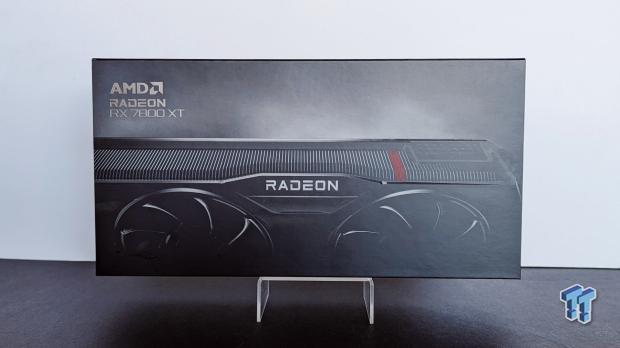
RDNA 3 also introduces hardware-based AV1 encoding to step up its video game for content creators, which means better quality video using the same bitrate. Very cool. For gamers, the introduction of AMD FSR 2 rendering is fully supported here and helps improve performance in intensive games. FSR 2 support might not be as widespread as NVIDIA DLSS, but its addition to games like Cyberpunk 2077 and Starfield is a great sign. Plus, as the tech is fully supported on Xbox Series X|S and PlayStation 5 (with both consoles using AMD graphics hardware), in-game FSR support should grow as time passes.
AMD's DLSS 3-like FSR 3 frame generation technology called 'AMD Fluid Motion Frames' will debut in September 2023 after this review goes live. FSR 3, like FSR 2, will be platform agnostic in that it will work across AMD, NVIDIA, and Intel hardware - but on RDNA 3 and Radeon GPUs, it will take advantage of the new Anti-Lag+ to reduce latency (something NVIDIA alleviates by pairing DLSS 3 with its Reflex latency reduction technology). Ultimately, RDNA 3 is an impressive leap forward for AMD, bringing massive changes to the underlying hardware while delivering a sizable performance leap over the previous RDNA 2 generation.
Specs and Test System
Specifications
Here, we can see how the specs and hardware stack up for the AMD Radeon RX 7700 XT and 7800 XT compares to the previous generation's AMD Radeon RX 6700 XT and 6800 XT.
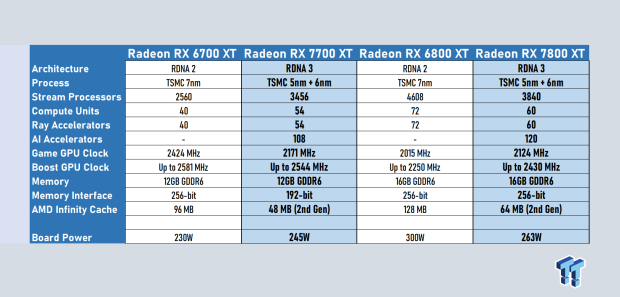
Although the Radeon RX 7800 XT is the generational successor to the Radeon RX 6800 XT, specs-wise, you're looking at two very different products - the latter based on AMD's flagship GPU, Navi 21, with the new Radeon RX 7800 XT presenting a fully unlocked Navi 32. And with that, you've got a 16.7% reduction in the Stream Processor, Compute Unit, and Ray Accelerator counts, half of the AMD Infinity Cache, and only a modest increase in clock speeds.
Of course, RDNA 3 brings a lot to the table, and several improvements have been made under the hood - so to speak - with better ray-tracing performance and the next generation of AMD Infinity Cache. And with that, the Radeon RX 7800 XT can do much more with less, with performance sitting above the Radeon RX 6800 XT in a more efficient package. It's not at the efficiency levels of NVIDIA's new Ada Lovelace architecture, but it's great to see AMD opt for a lower power draw for its successor to the Radeon RX 6800 XT.
And in a spot of good news, the Radeon RX 7800 XT retains the 16GB of GDDR6 memory found in the 6800 XT, making it the most affordable (and performant) 16GB GPU on the market. This helps the card's overall performance when pushing higher resolutions like 1440p and 4K, enabling effects like ray-tracing, which can quickly chew through VRAM. AMD is marketing the Radeon RX 7800 XT as its 1440p killer for the current generation (for 4K, it suggests the Radeon RX 7900 Series), but with 16Gb of VRAM and plenty of RDNA 3 grunt - it's decent for 4K gaming too.
- GPU: AMD Radeon RX 7800 XT
- Model: AMD Radeon RX 7800 XT Reference
- Interface: PCI Express 4.0
- Stream Processors: 3840
- Compute Units/Ray Accelerators/AI Accelerators: 60/60/120
- Clock Speeds: Boost Clock: Up to 2430 MHz, Game Clock: 2124 MHz
- Memory: 16GB GDDR6
- Memory Speed: 19.5 Gbps
- Memory Interface: 256-bit
- Display Connections: 1 x HDMI 2.1, 3 x DisplayPort 2.1
- Power Connectors: 2 x 8-pin
- Total Board Power: 263W
- What's in the Box: AMD Radeon RX 7800 XT Reference GPU, Welcome Card
Kosta's Test System
- Motherboard: MSI MPG X670E Carbon Wi-Fi
- CPU: AMD Ryzen 9 7900X
- Cooler: Corsair iCUE H100i RGB PRO XT Liquid CPU Cooler
- RAM: 64GB (2x32GB) Corsair DOMINATOR PLATINUM RGB DDR5 DRAM 5200MHz
- SSD: Sabrent Rocket 4 Plus-G M.2 PCIe Gen 4 SSD 4TB, Sabrent Rocket 4 Plus M.2 PCIe Gen 4 SSD 8TB
- Power Supply: Thermaltake Toughpower GF1 850W
- Case: Thermaltake Core P3 Tempered Glass Snow
- OS: Microsoft Windows 11 Pro 64-bit
Physical Design and Cooling
The AMD's reference Radeon RX 7800 XT design follows in the footsteps of what we saw with the Radeon RX 7900 XT, 7900 XTX, and even the 7600 - the result being a visual showpiece. With its fully enclosed metal construction, dual axial fan cooling, and stylish Radeon accents and flourishes, the Radeon RX 7800 XT reference model is also surprisingly compact. With a dual-fan design and dimensions of around 270 x 100 x 50mm, you're looking at a 2.5-slot GPU with an overall sturdy weight of 1110 grams.
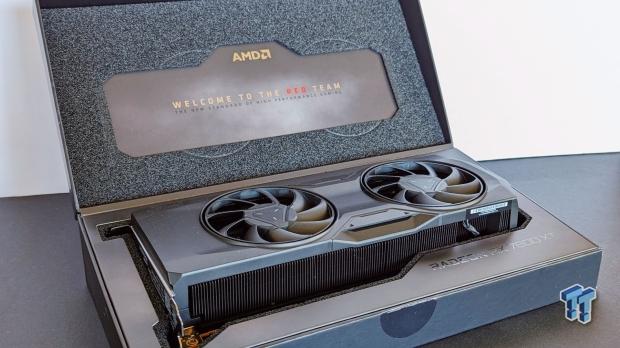
Based on the size of most high-end cards out there, it's always great to see a more compact GPU deliver excellent performance, and on top of that, you've got AMD's most stylish design to date. This also means it can fit into most cases with relative ease and could even be a great option for smaller builds and cases about maximizing space with compact components.
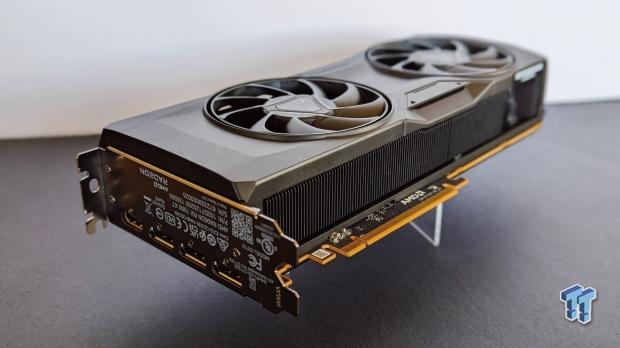
However, there is a catch in that, like AMD's other reference models for the RDNA 3 generation, the Radeon RX 7800 XT runs warmer and hotter than alternative models from its AIB partners. When idle, the reference design remains silent when temperatures drop below a certain threshold - as in the fans stop. For those looking at overclocking or Radeon RX 7800 XT models that run cooler (and quieter), be sure to check out our upcoming reviews of the Sapphire NITRO+ AMD Radeon RX 7800 XT Gaming OC and ASRock Radeon RX 7800 XT Phantom Gaming OC.
Benchmarks - 15 Game Averages
The Games and Tests
In 2023, PC gaming is a complicated and varied space, from indie games to major blockbuster releases and titles that push hardware and technology to their limit with the adoption of effects like real-time ray-tracing.
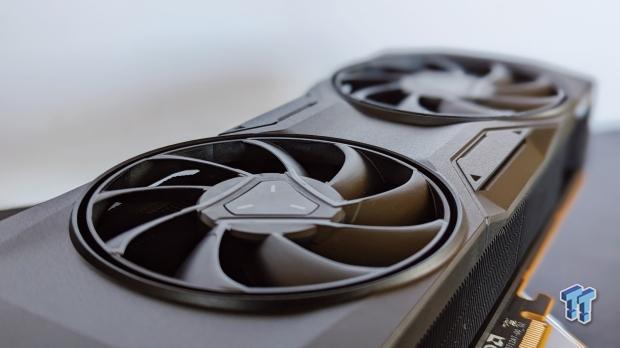
This is all a way of saying that the 15 in-game benchmarks we've chosen (run at 1080p, 1440p, and 4K) represent a wide range of styles, not only in terms of genres, like first-person shooters and racing games, but also in the API technology (DirectX 11, 12) and cutting-edge features like ray tracing and upscaling technology.
Results include DLSS and FSR 2, where possible, as both technologies are the sorts of things, especially in 1440p and 4K, which you'd turn on. Six of the 15 game benchmarks also feature ray tracing. Also, each title is set to ultra-equivalent quality settings to push GPU hardware and minimize CPU bottlenecks at higher resolutions.
Also, it's just fun to max out a game's visual settings and see the results. Here's the breakdown of games, graphics settings, and what's being tested.
- Assassin's Creed Valhalla: Ultra High-quality settings, with the in-game benchmark tool used.
- Borderlands 3: Ultra quality settings, with the in-game benchmark tool used.
- Call of Duty: Modern Warfare II: Ultra quality setting, in-game multiplayer benchmark tool used. AMD FSR 2 and NVIDIA DLSS results are included.
- Cyberpunk 2077: Ultra quality setting, in-game benchmark tool used. AMD FSR 2 and NVIDIA DLSS results are included.
- Cyberpunk 2077 (RT): Ray tracing Ultra quality setting, in-game benchmark tool used. AMD FSR 2 and NVIDIA DLSS results are included.
- DOOM Eternal (RT): Ultra Nightmare quality setting with ray-tracing enabled, the opening of Mars Core campaign level used to benchmark. NVIDIA DLSS results included.
- F1 22 (RT): Ultra High-quality setting with ray tracing, one lap of the Bahrain track benchmarked. AMD FSR 2 and NVIDIA DLSS results are included.
- Forza Horizon 5 (RT): Extreme quality setting with ray tracing enabled, in-game benchmark tool used. AMD FSR 2 and NVIDIA DLSS results are included.
- Hitman (RT): Ultra-quality settings with ray-tracing, Dubai scene benchmarked. AMD FSR 2 and NVIDIA DLSS results are included.
- Horizon Zero Dawn: Ultimate quality setting, in-game benchmark used.
- Marvel's Guardians of the Galaxy (RT): Ultra quality setting with ray tracing enabled, the in-game benchmark tool used. NVIDIA DLSS results included.
- Rainbow Six Extraction: Ultra quality settings and in-game benchmark tool used. NVIDIA DLSS results included.
- Red Dead Redemption 2: Maximum quality settings, with in-game benchmark tool used. AMD FSR 2 and NVIDIA DLSS results are included.
- The Division 2: Ultra quality settings with in-game benchmark tool used.
- Total War: Warhammer III: Ultra-quality settings with the in-game Battle Benchmark tool used.
15 Game Average FPS - 1080p Results
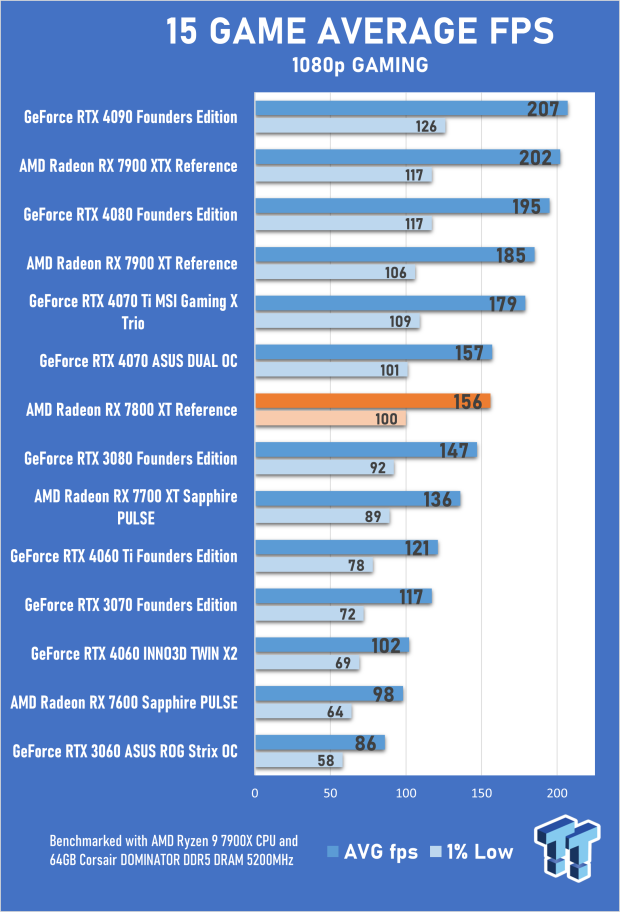
With a mix of games and benchmarks with and without ray-tracing, the 1080p and 1440p results for the Radeon RX 7800 XT show its performance is roughly on par with the GeForce RTX 4070. You might think these cards are interchangeable just by looking at this chart. Naturally, the full story is much more nuanced, where it's a back-and-forth that ultimately sees the average performance for both lineup.
Here, we also see a 14.7% 1080p performance increase for the Radeon RX 7800 XT compared to the Radeon RX 7700 XT - which does make the 7700 XT, which is only 11% cheaper, feel like not as great of a deal. It's a shame I didn't have a Radeon RX 6800 XT to get some exact gen-on-gen numbers. Still, based on several reviews showcasing that the GeForce RTX 4070 is around 8-10% faster than the Radeon RX 6800 XT (on average) - the Radeon RX 7800 XT only begins to look as good as it does when you factor in the price point.
14 Game Average FPS - 1440p Results
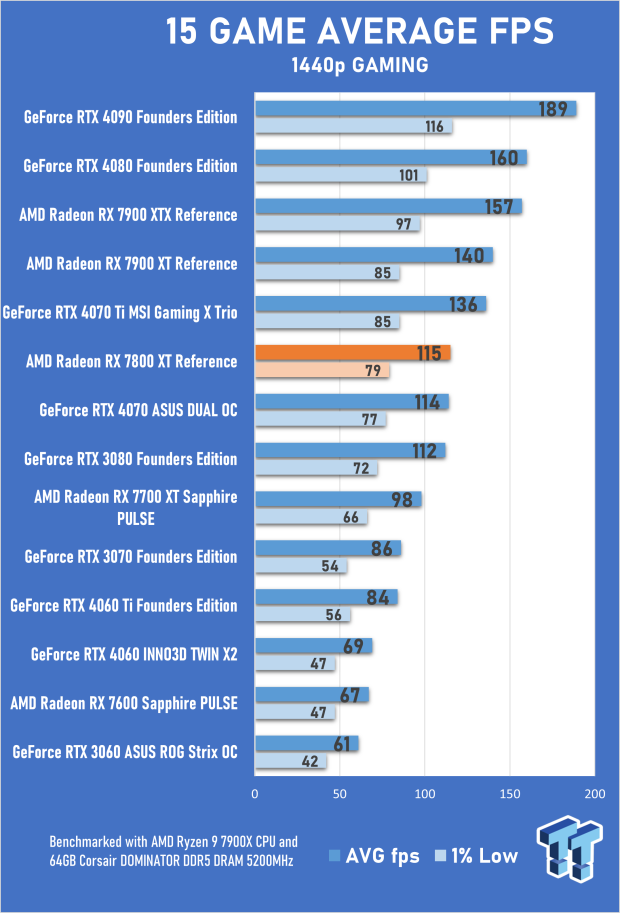
The Radeon RX 7800 XT (and the 7700 XT) are cards tailor-made for 1440p gaming across all titles, including major AAA releases, with advanced visual effects. And yes, even ray-tracing - though this is where we begin to see some cracks. Per the chart, the Radeon RX 7800 XT performs roughly on par with the GeForce RTX 4070 - though its performance lead over the Radeon RX 7700 XT grows to 17.8%.
The back-and-forth seen at 1080p continues here with some very interesting results. Take Cyberpunk 2077 as an example; using the Ultra in-game settings, the Radeon RX 7800 XT delivers a result 20% faster than the GeForce RTX 4070. Switch this to RT Ultra, and the 7800 XT falls behind by 30%. It's a pretty sizeable gap indicative of other RT-heavy games like Hitman. However, the flip side is that the Radeon RX 7800 XT outperforms the GeForce RTX 4070 and GeForce RTX 4070 Ti in Call of Duty: Modern Warfare II in one of the card's best showings. On the other hand, you've got titles like Assassin's Creed Valhalla and F1 22 performing roughly the same.
With a triple-digit average across all 15 games benchmarked, the Radeon RX 7800 XT is indeed a 1440p performer - especially when you factor in that this result doesn't include AMD's FSR 2 upscaling.
15 Game Average FPS - 4K Results
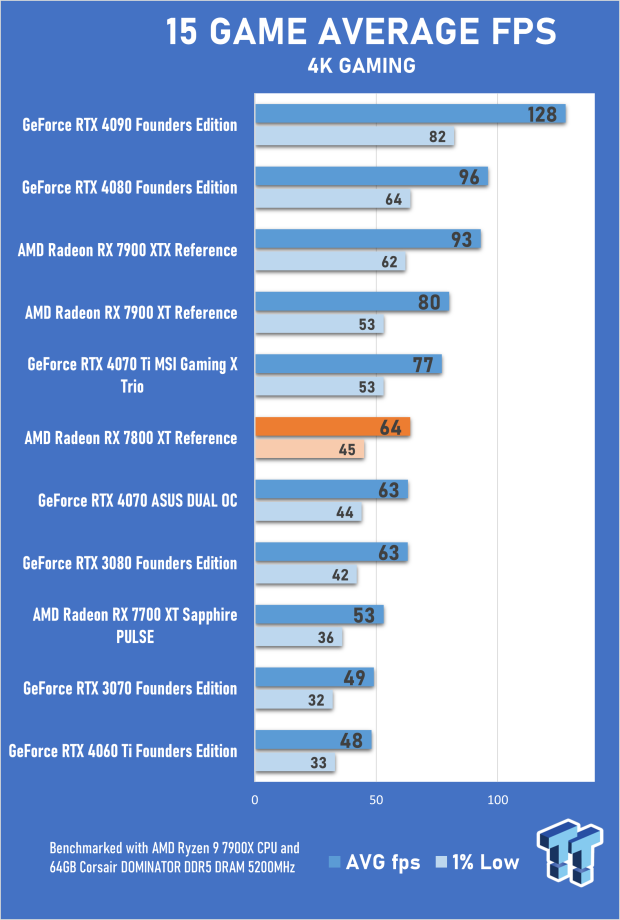
Is the Radeon RX 7800 XT a 4K gaming GPU? The answer to that depends on several factors - the game, the settings, whether or not you've RT effects enabled, and if there's an option to turn on FSR 2 at the Quality setting. However, even with that preamble, the answer is sure if the target is 60fps. But the 7800 XT's performance drop off when increasing the resolution to 4K from 1440p is a sizeable 44% - so this resolution pushes it.
Once again, the overall numbers are virtually identical to the GeForce RTX 4070, even with the Radeon RX 7800 XT's additional memory - 16GB compared to 12GB. And it's here, too, where the performance increase compared to the Radeon RX 7700 XT ramps up even higher - to 20%. This is a figure that solidifies the 7800 XT as the better choice.
Benchmarks - 3DMark FireStrike
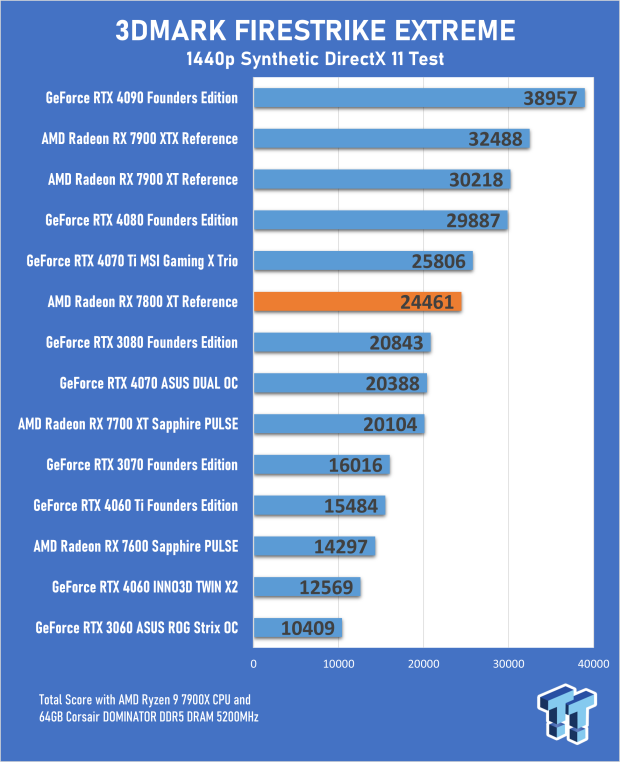
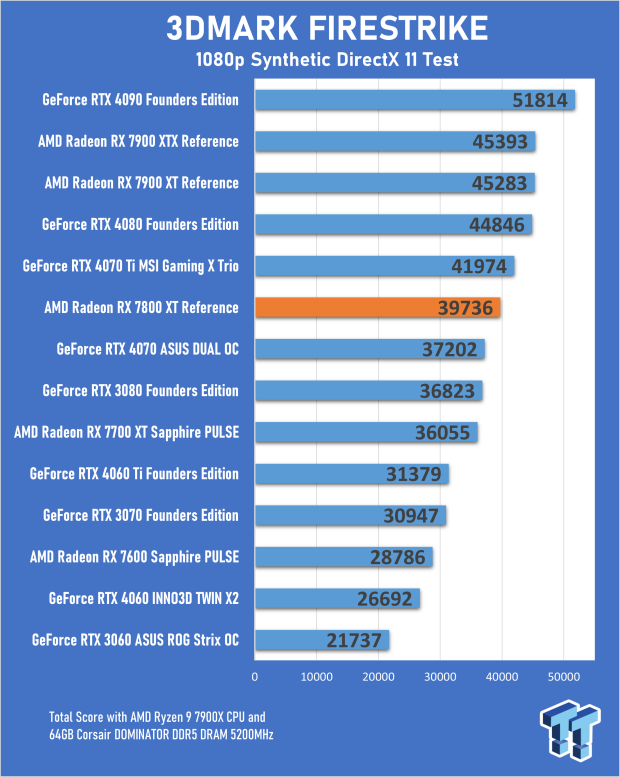
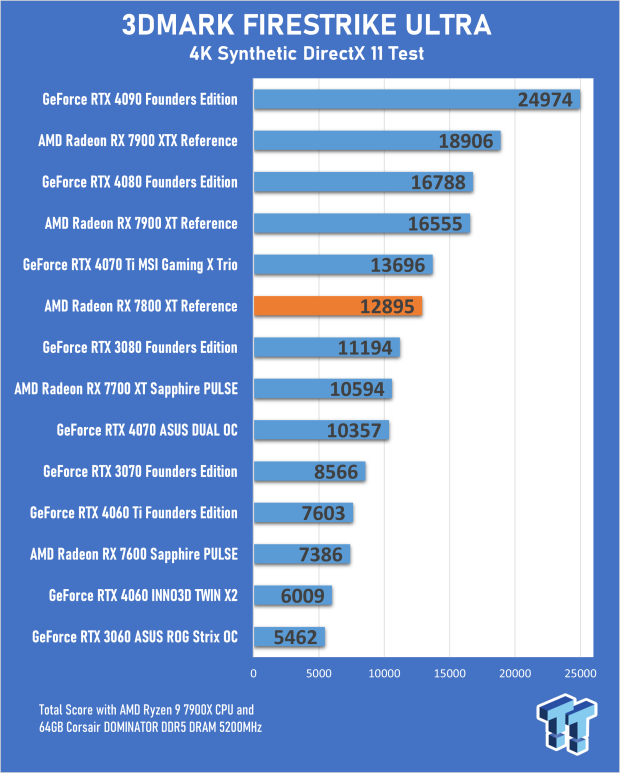
3DMark FireStrike is a DirectX 11 test that has been around for many years and covers quite a large portion of games released over the past decade - at least in terms of the API and graphics technologies used. The three tests cover the resolutions - 1080p, 1440p, and 4K. The 1440p test is the one highlighted above, and as a synthetic benchmark, it shows that the Radeon RX 7800 XT delivers a score 20% higher than the GeForce RTX 4070 and its RDNA 3 sibling, the Radeon RX 7700 XT.
As a synthetic benchmark, it's a result not entirely indicative of our in-game benchmark results as a whole - but in step with how wildly they vary from title to title.
Benchmarks - 3DMark TimeSpy and Port Royal
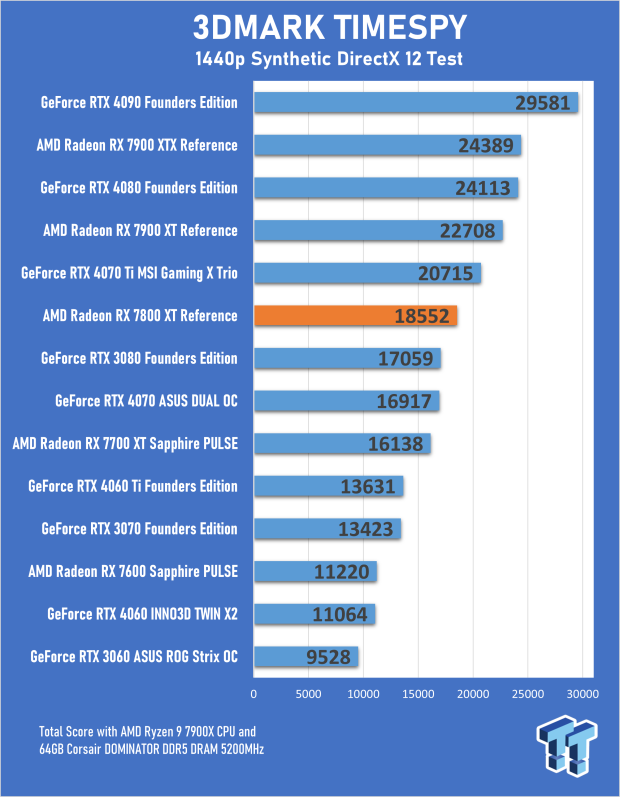
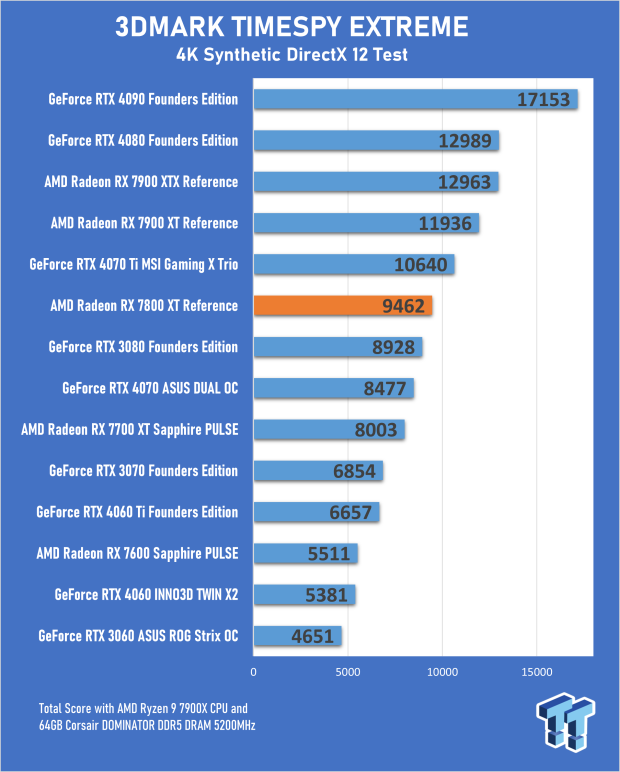
With 3DMark TimeSpy being DirectX 12-based, it's a more relevant synthetic benchmark for modern games. Here, we see results that more closely match the in-game benchmarks, with the Radeon RX 7800 XT's 1440p score 14.9% higher than the Radeon RX 7700 XT and 9.7% higher than the GeForce RTX 4070. The TimeSpy benchmark does not include ray-tracing, so the result is more in step with the non-RT games we tested. Plus, a score of 18,552 is very respectable and indicative of a powerful 1440p GPU.
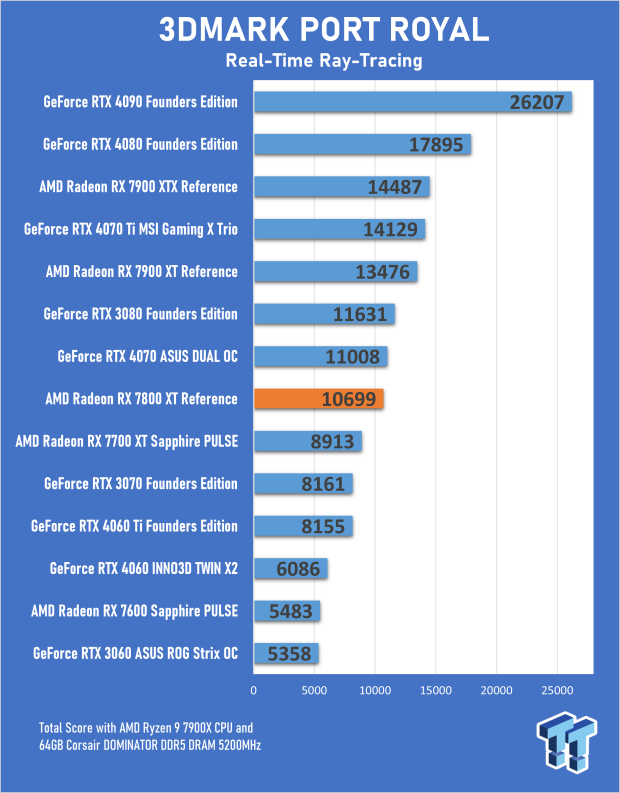
3DMark Port Royal is a synthetic ray-tracing benchmark, and surprisingly, the Radeon RX 7800 XT delivers a score fairly close to the GeForce RTX 4070 - it's only 2.8% lower. Even though in-game results do show a bigger disparity than this, the Radeon RX 7800 XT is generally a decent RT performer as long as ray-tracing effects are kept within limits or not set to Ultra-like settings.
F1 22, which features ray-tracing, sees the Radeon RX 7800 XT perform similarly to the GeForce RTX 4070. Cyberpunk 2077, with RT Ultra, sees the Radeon GPU fall apart - at least when compared to the GeForce RTX 4070. With this result and actual in-game results, it's clear that RDNA 3 RT performance is only impressive or "up there" regarding the flagship Radeon RX 7900 Series of GPUs.
Benchmarks - 1080p Gaming
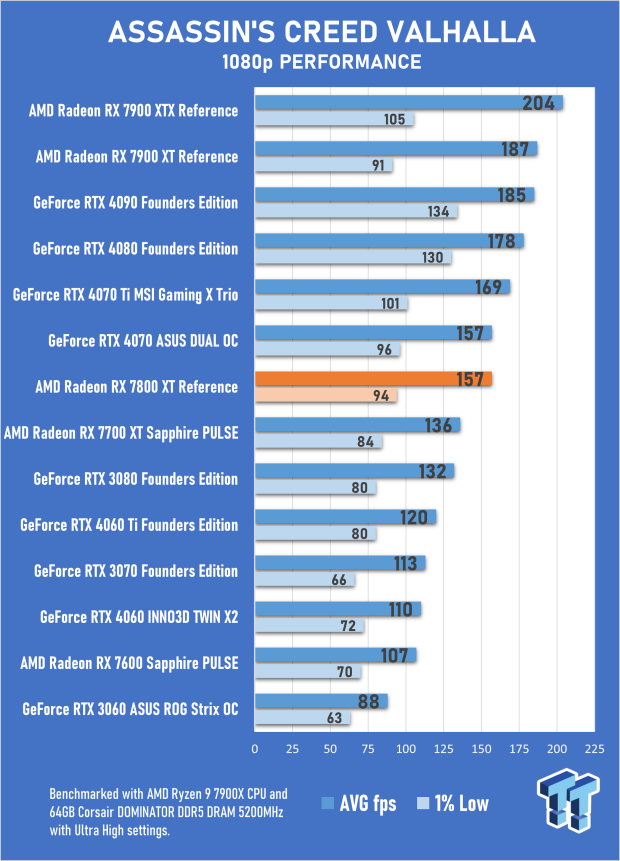
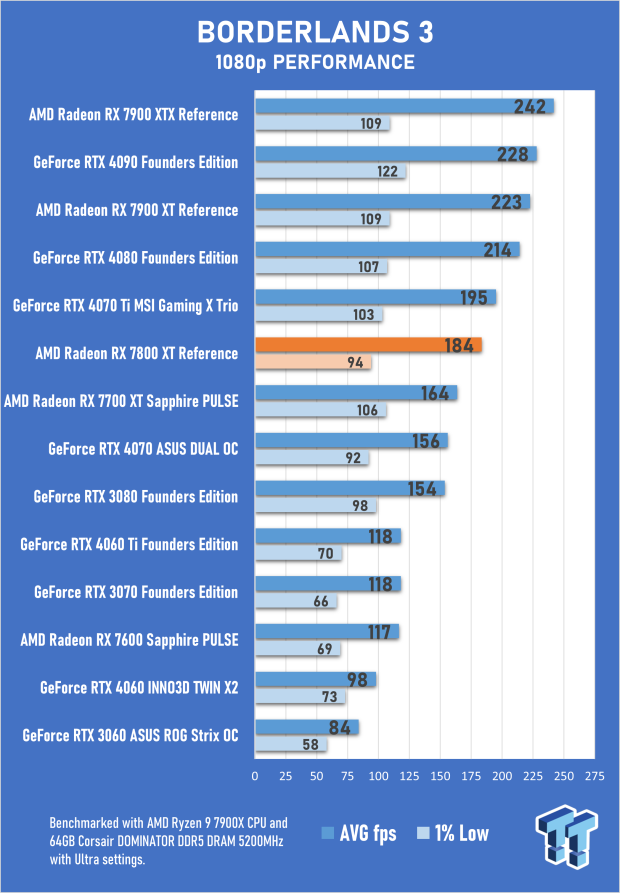
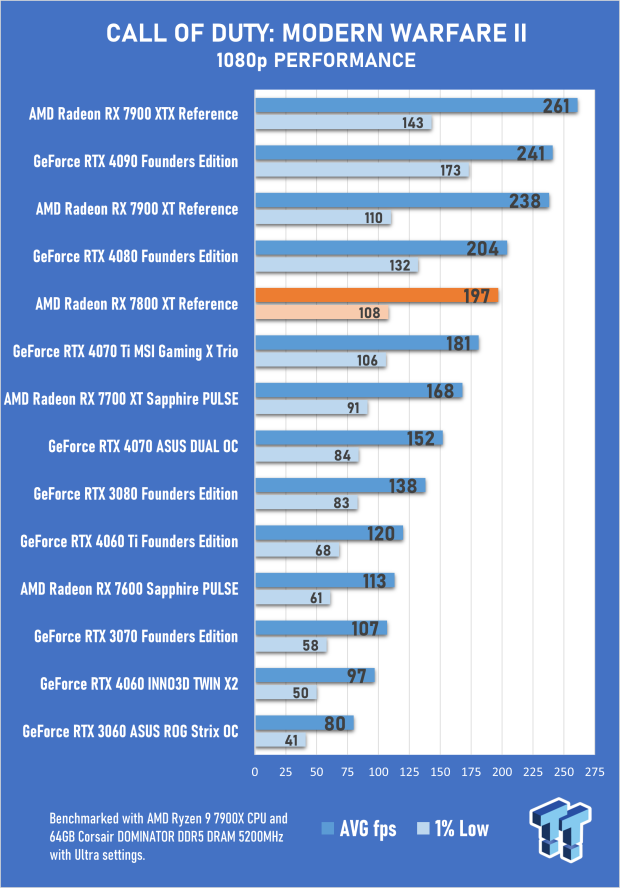
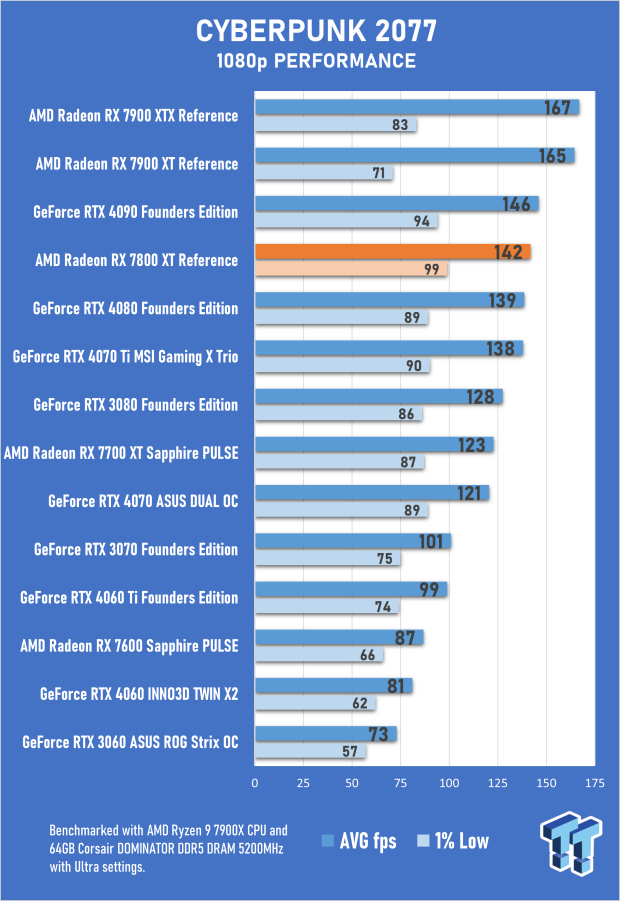
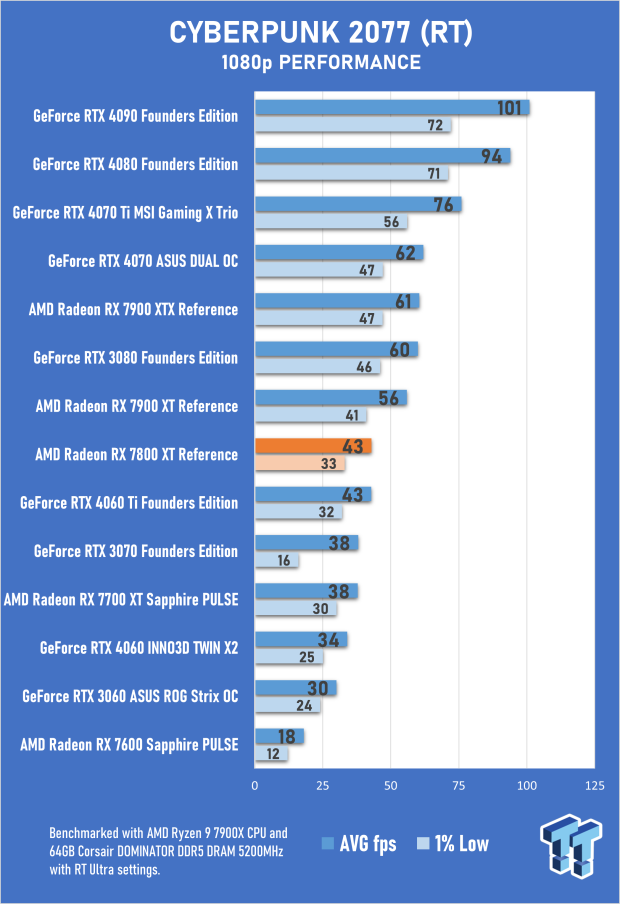
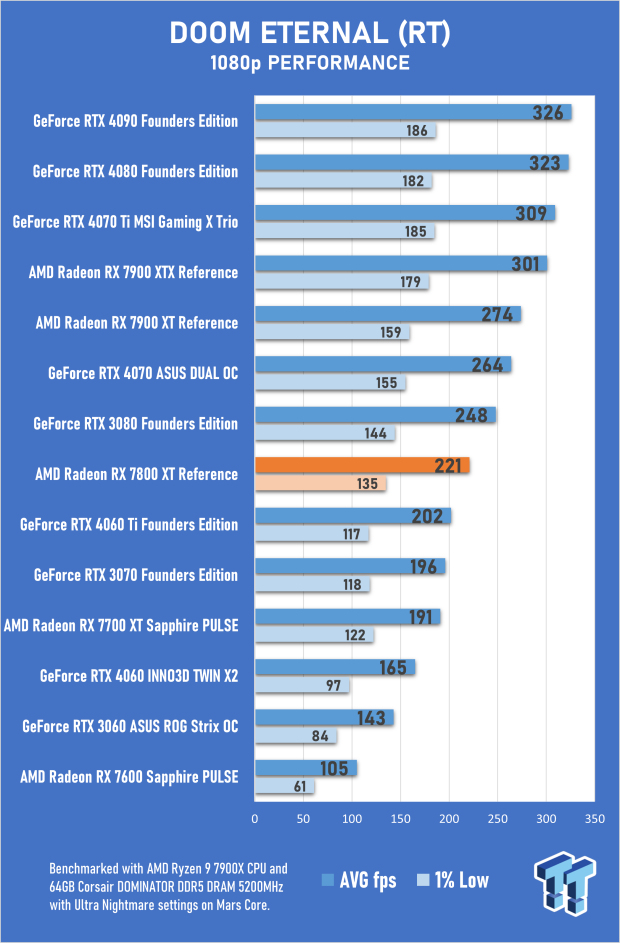
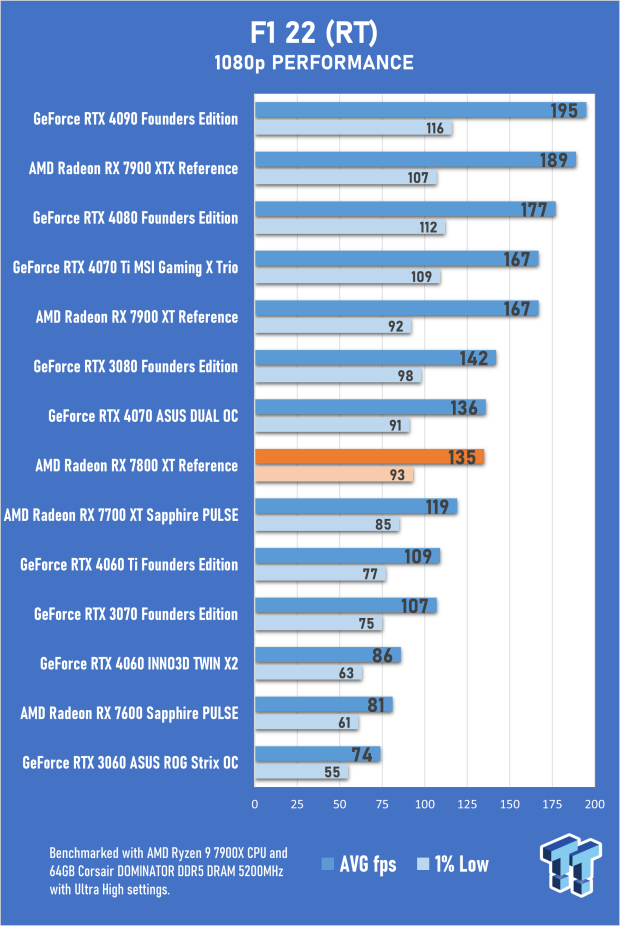
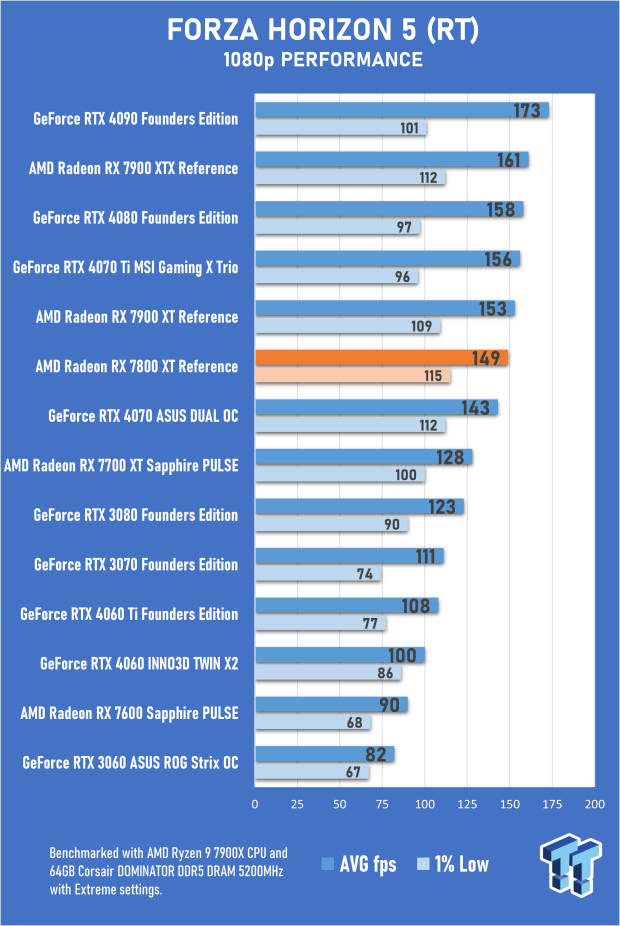
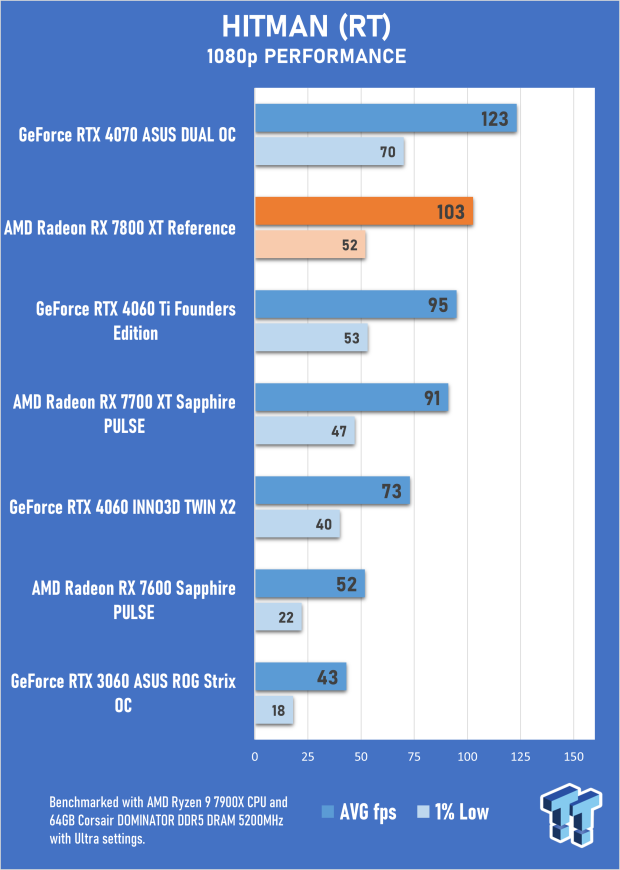
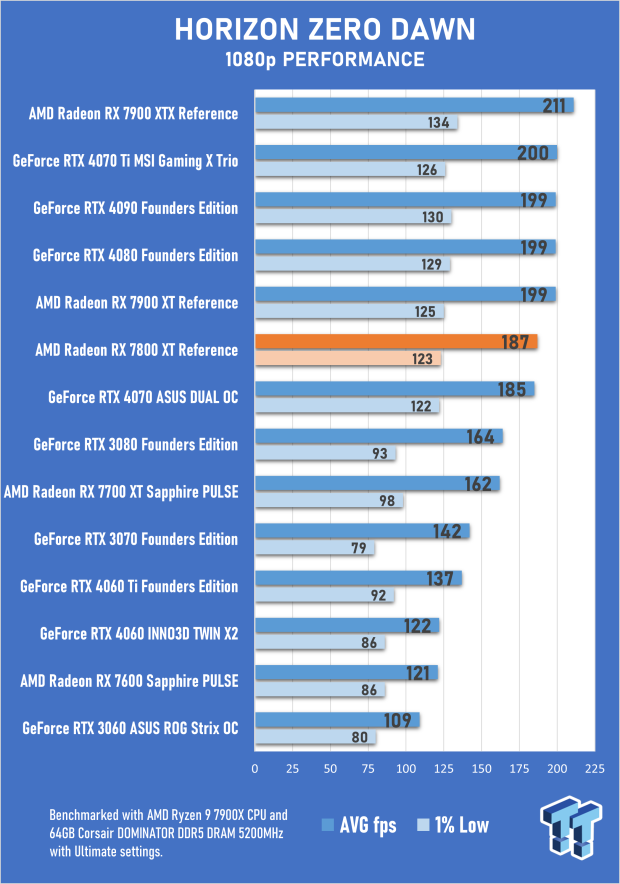
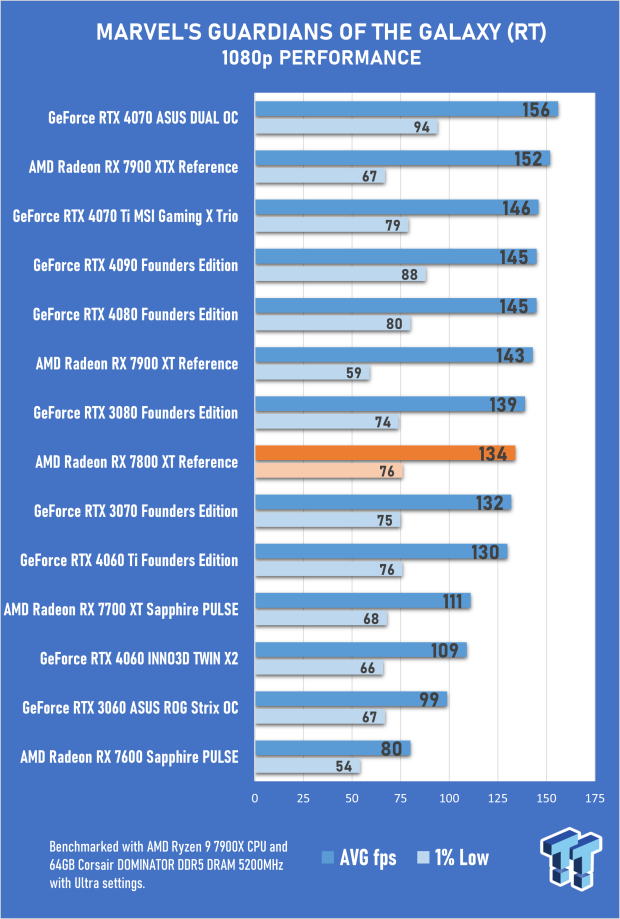
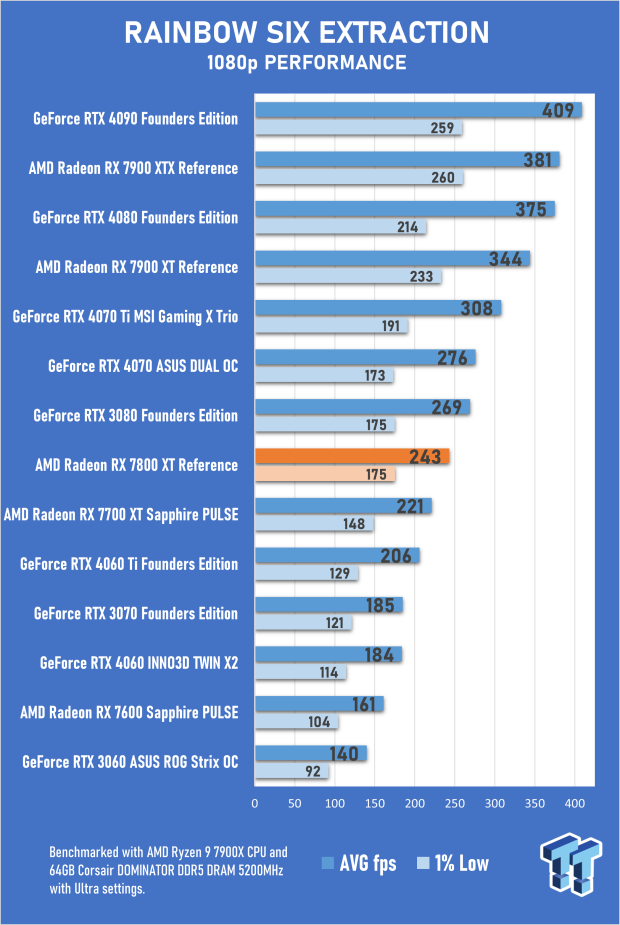
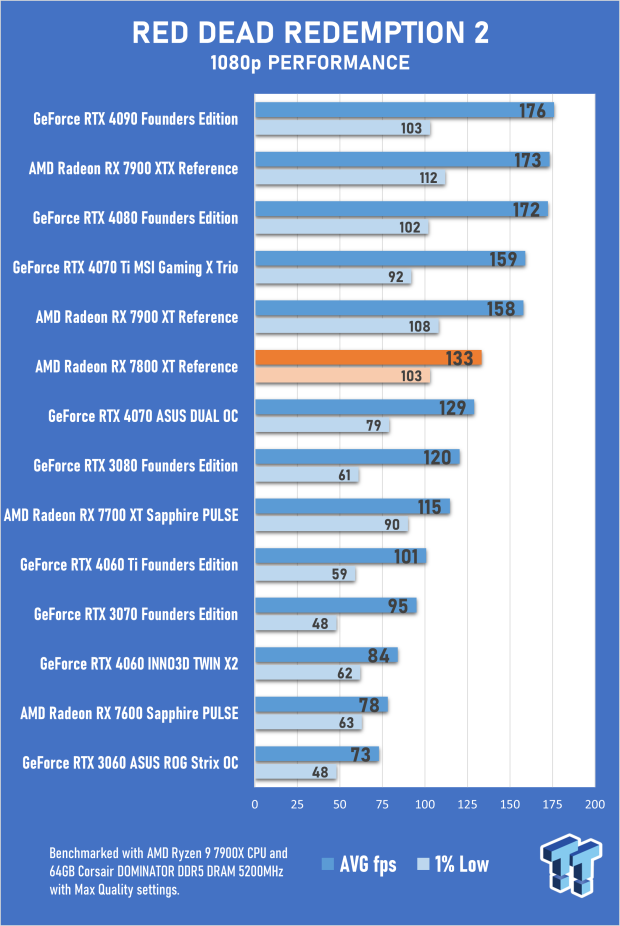
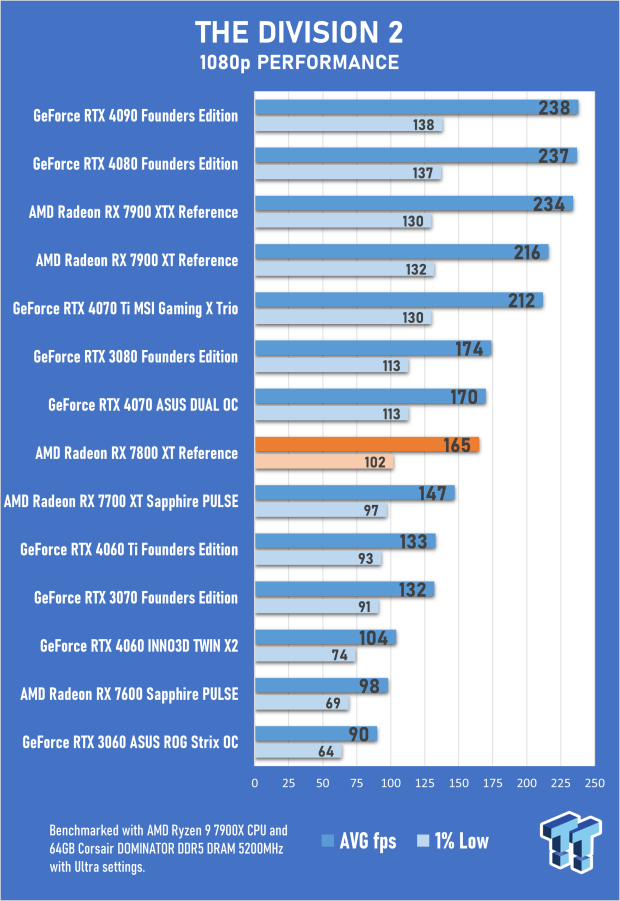
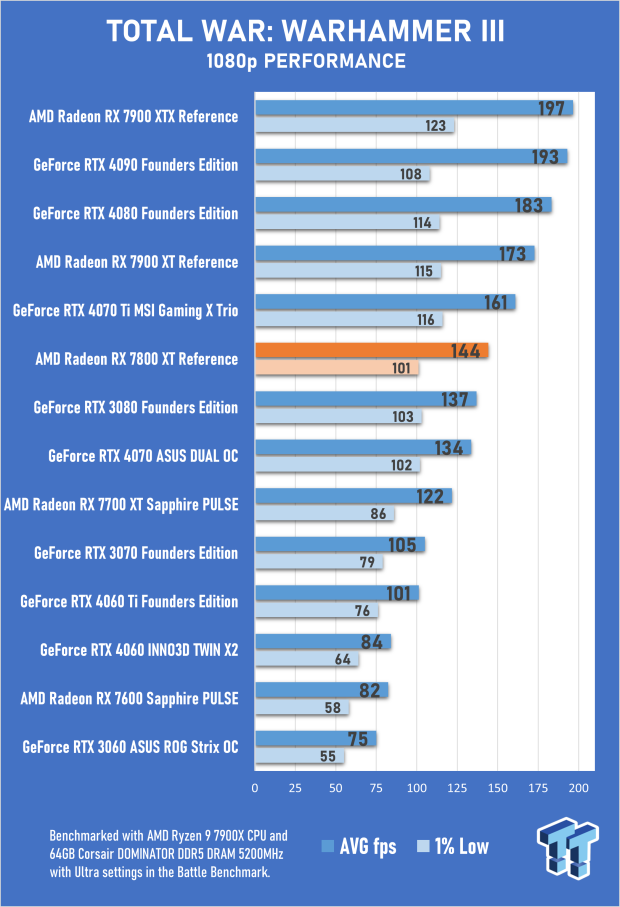
Benchmarks - 1440p Gaming
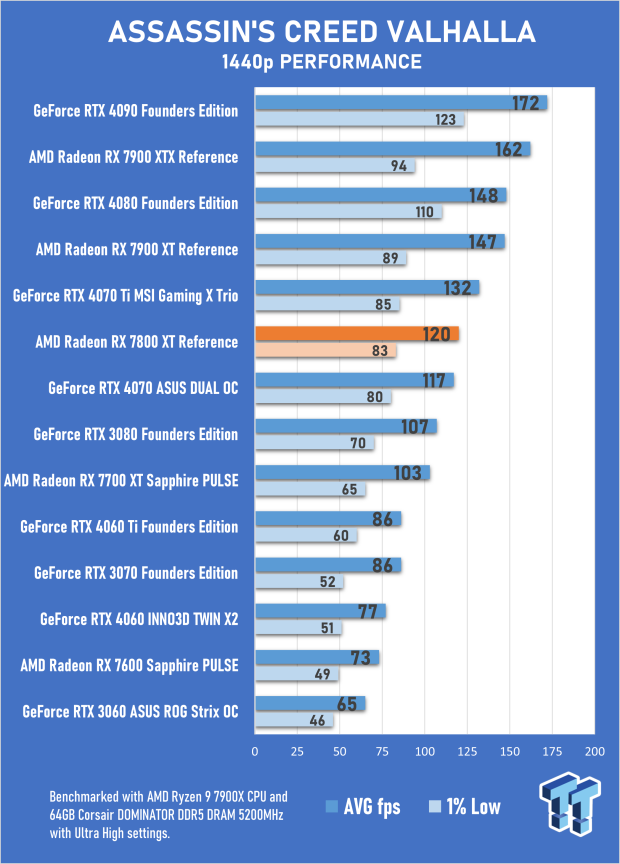
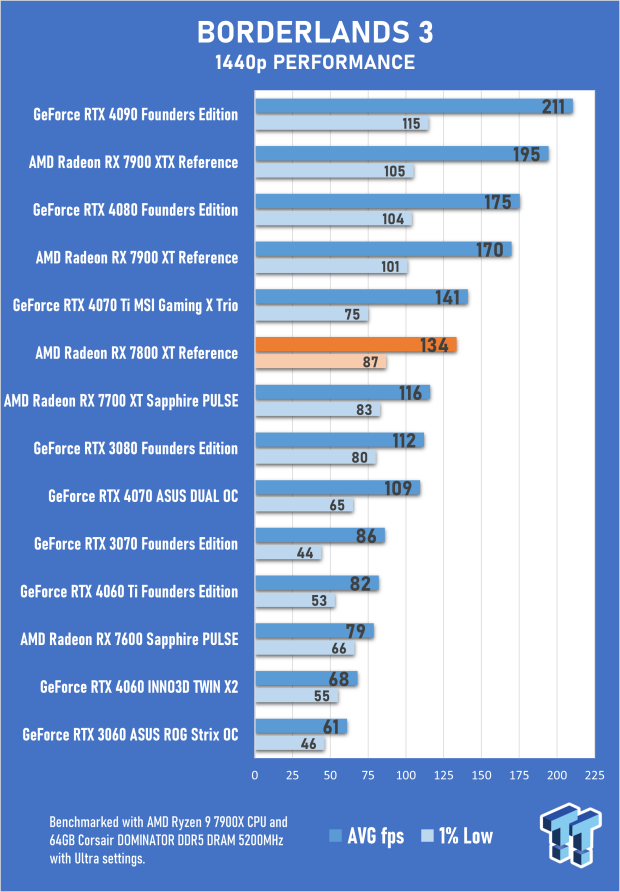
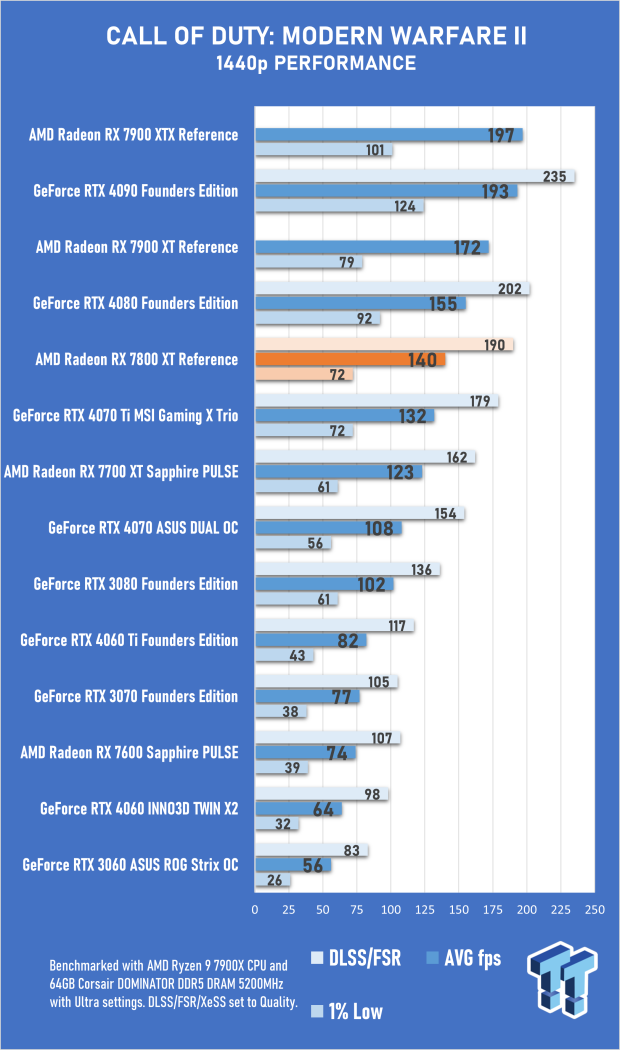
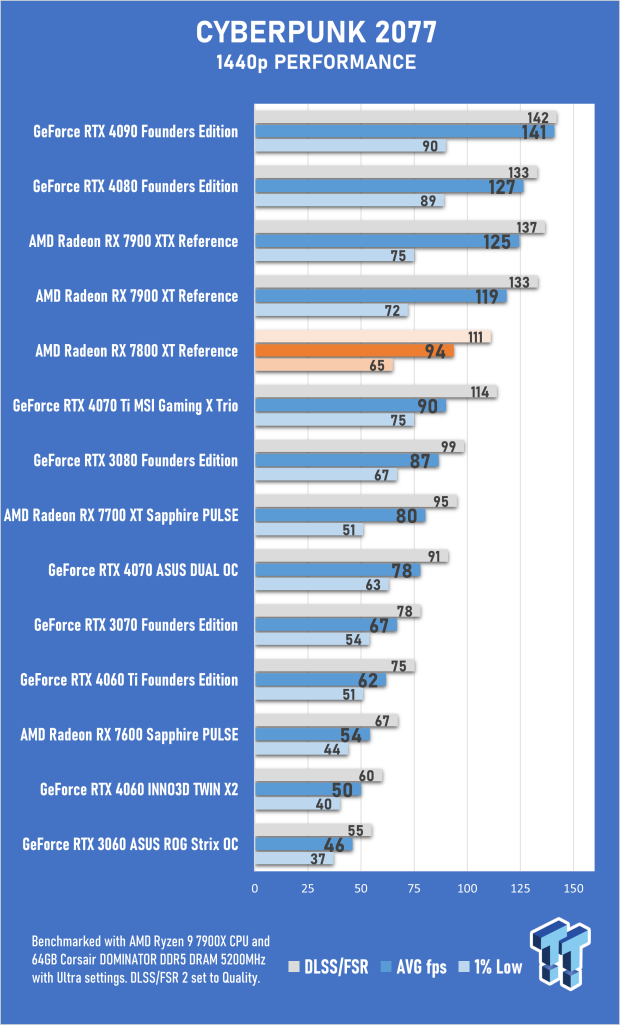
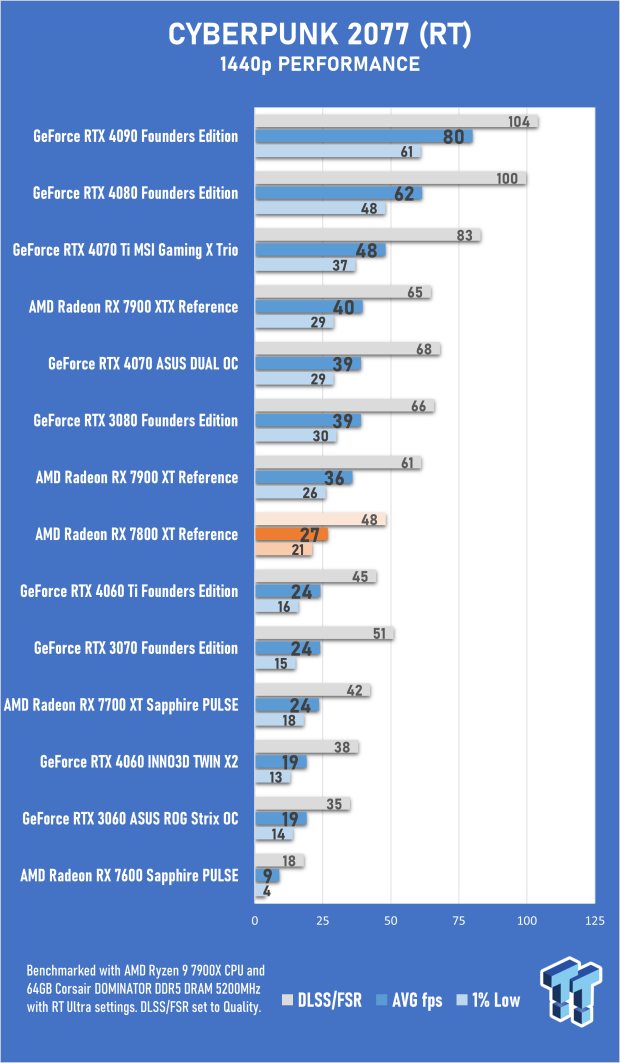
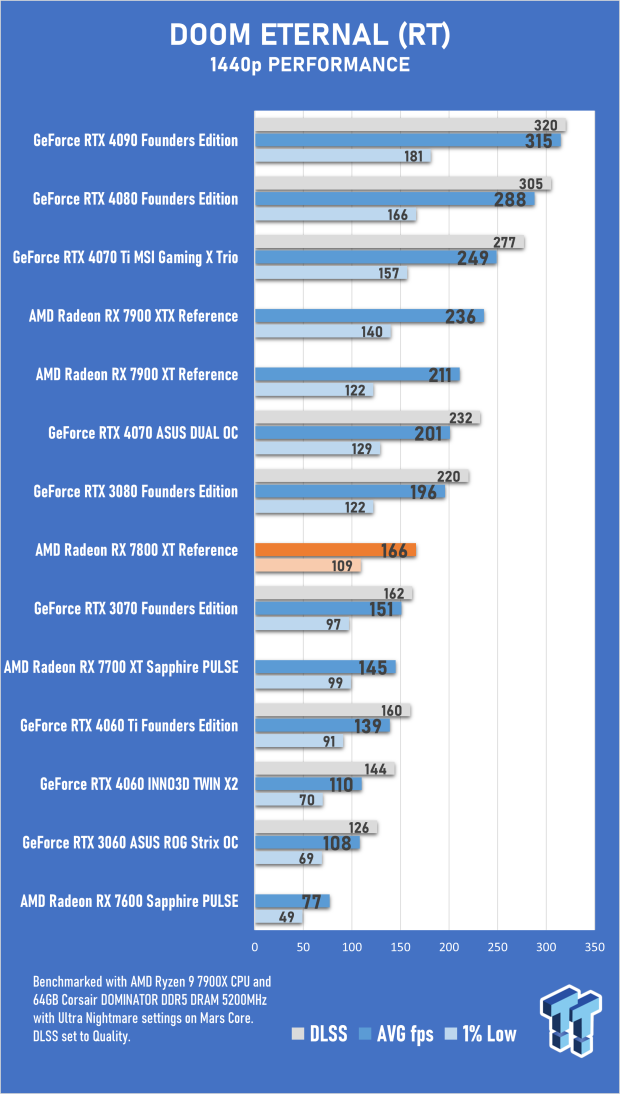
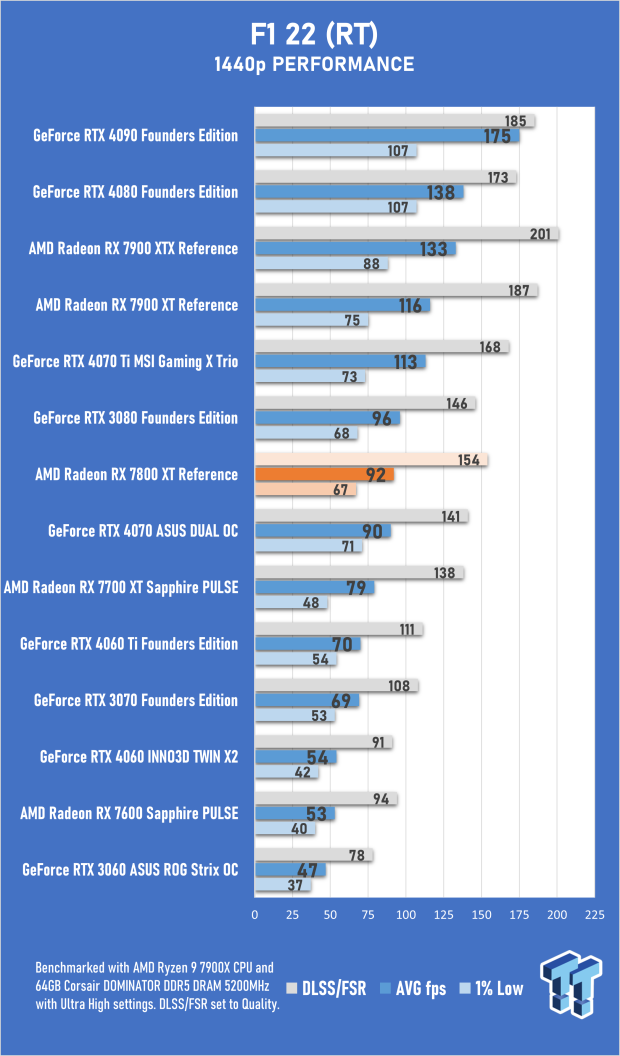
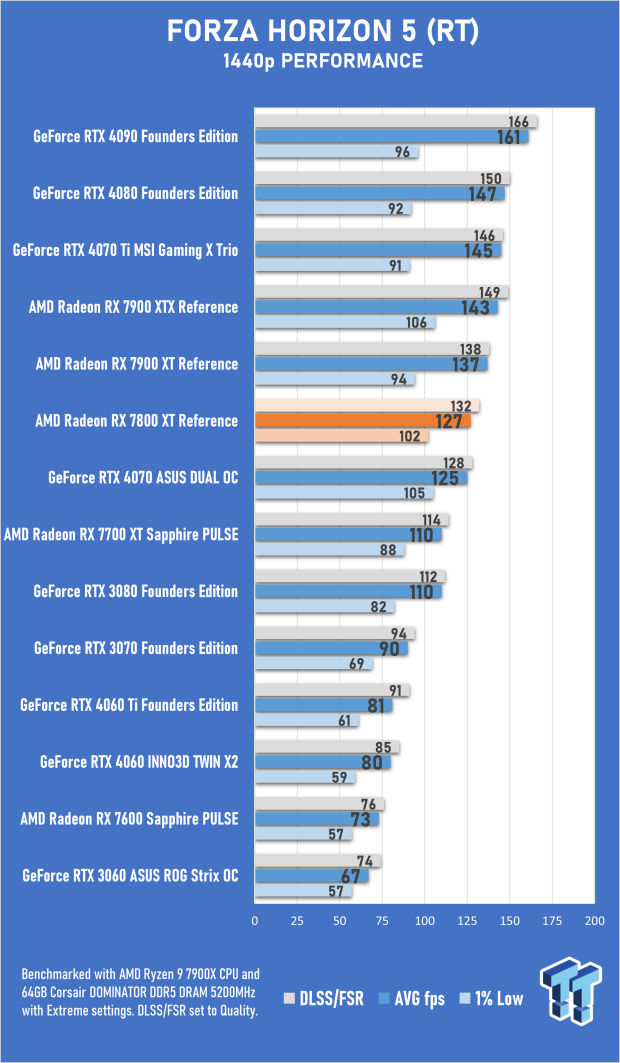
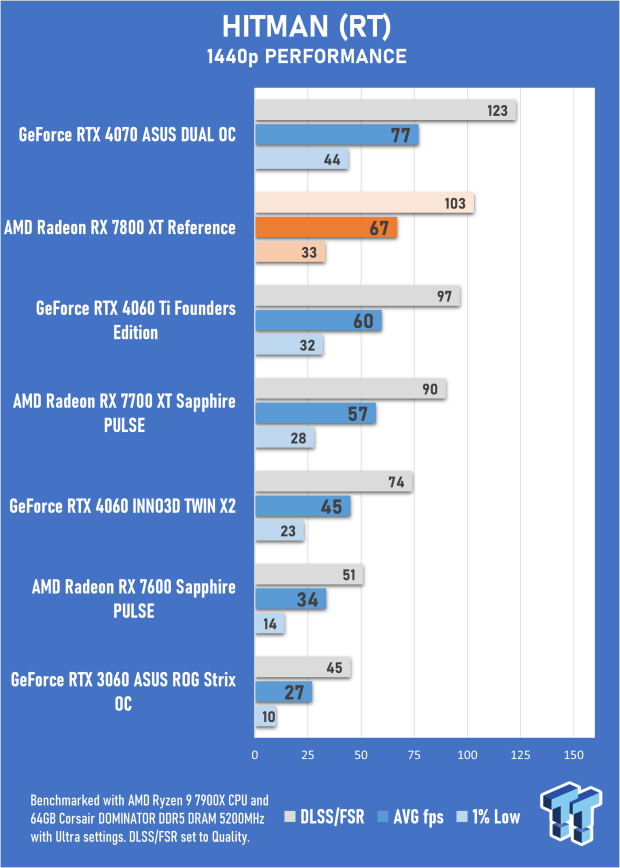
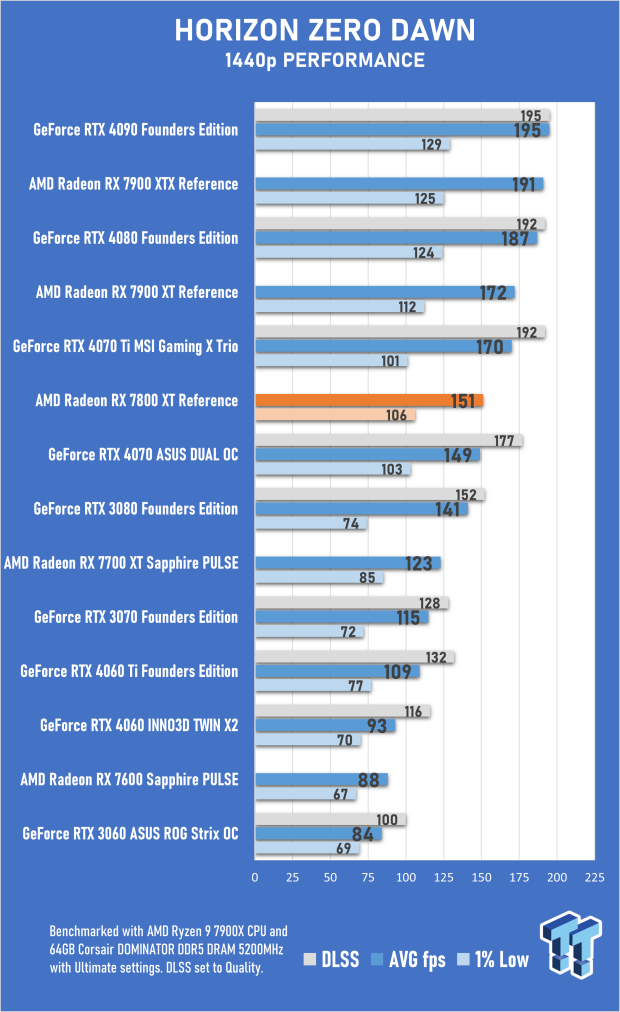
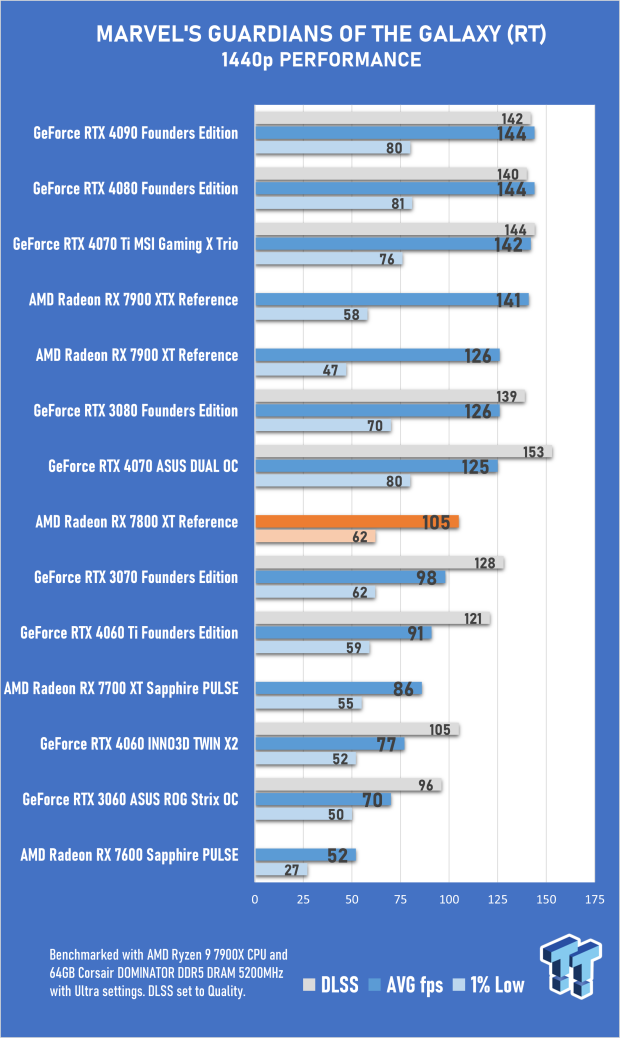
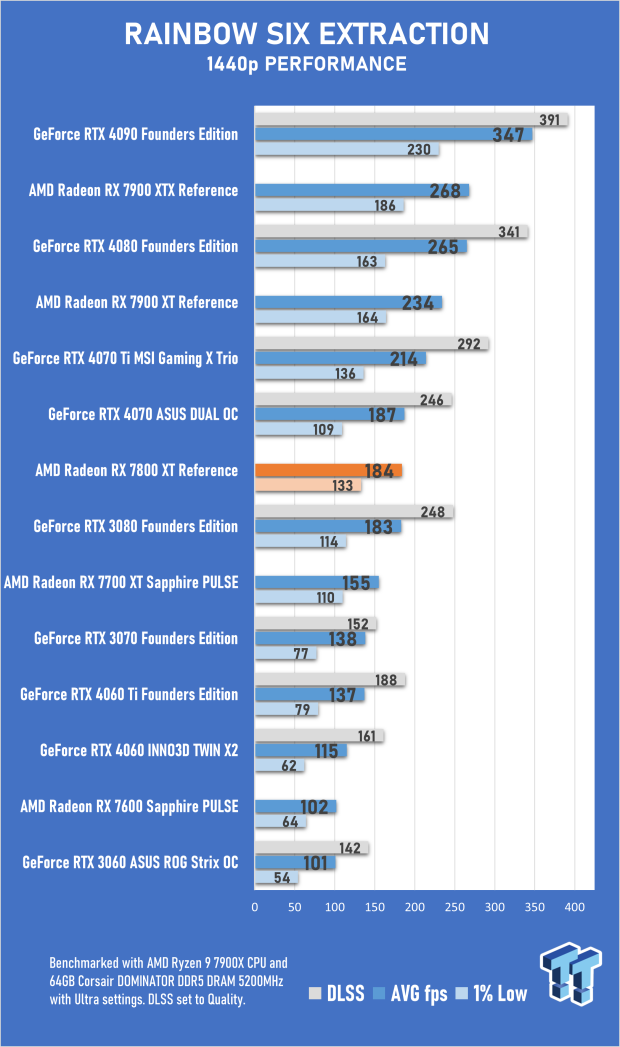
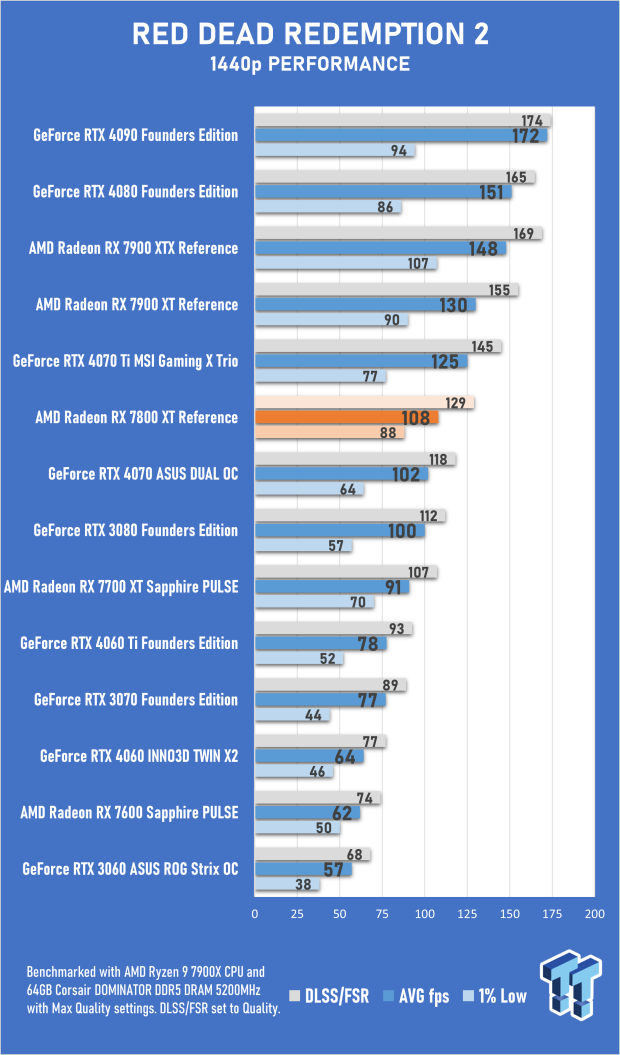
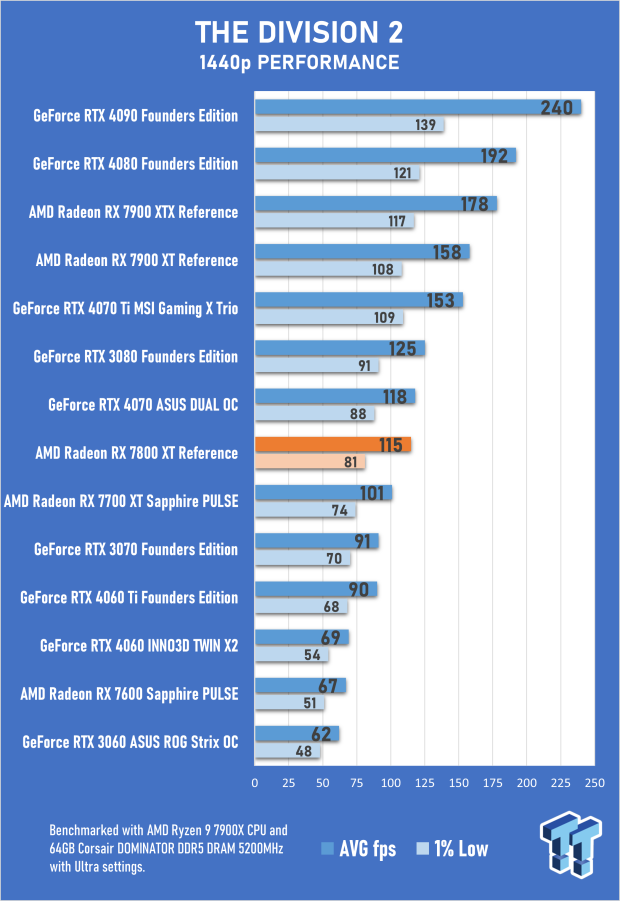
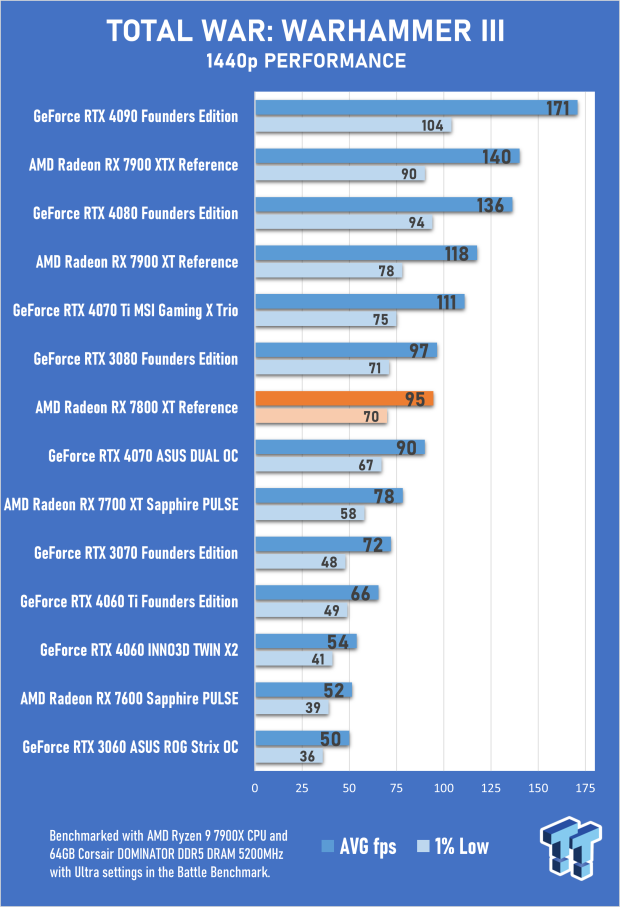
Benchmarks - 4K Gaming
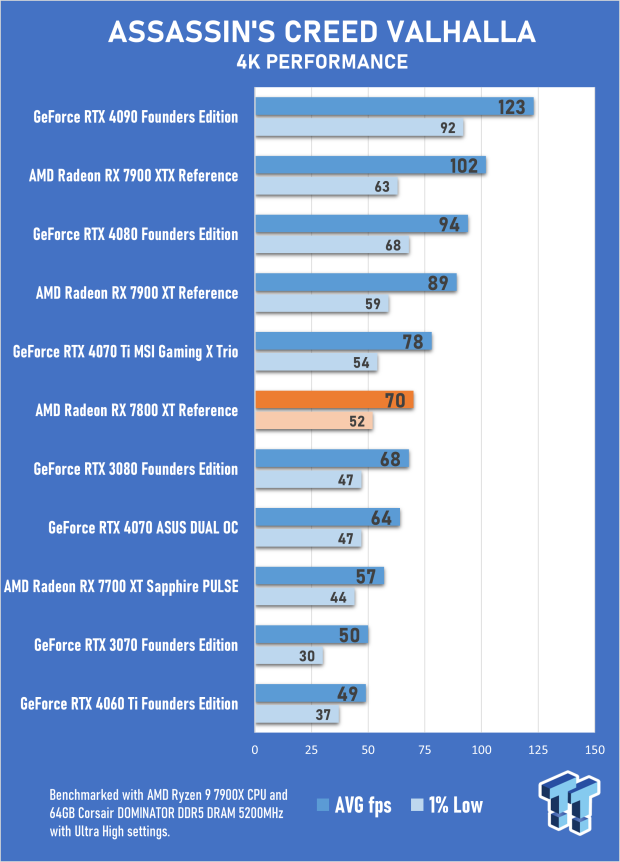
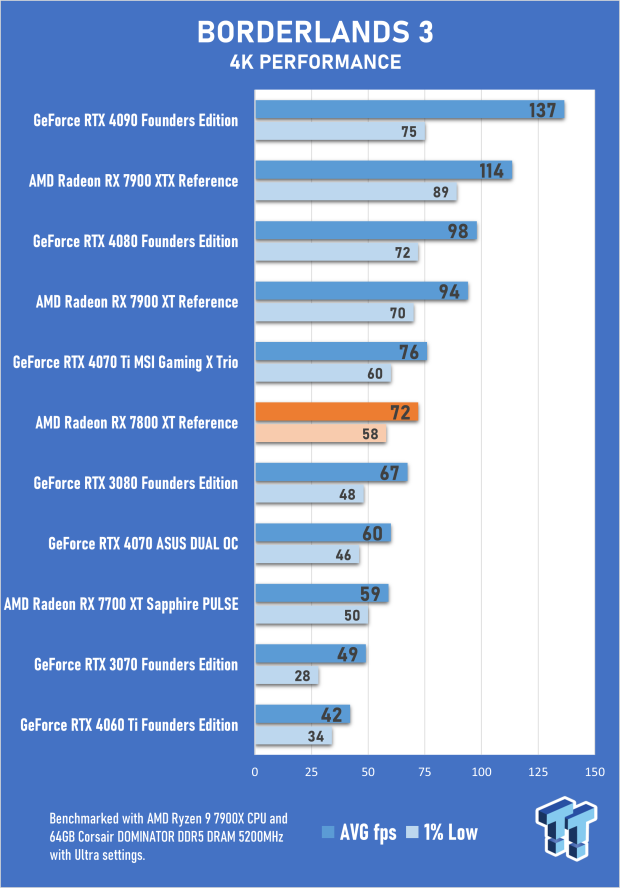
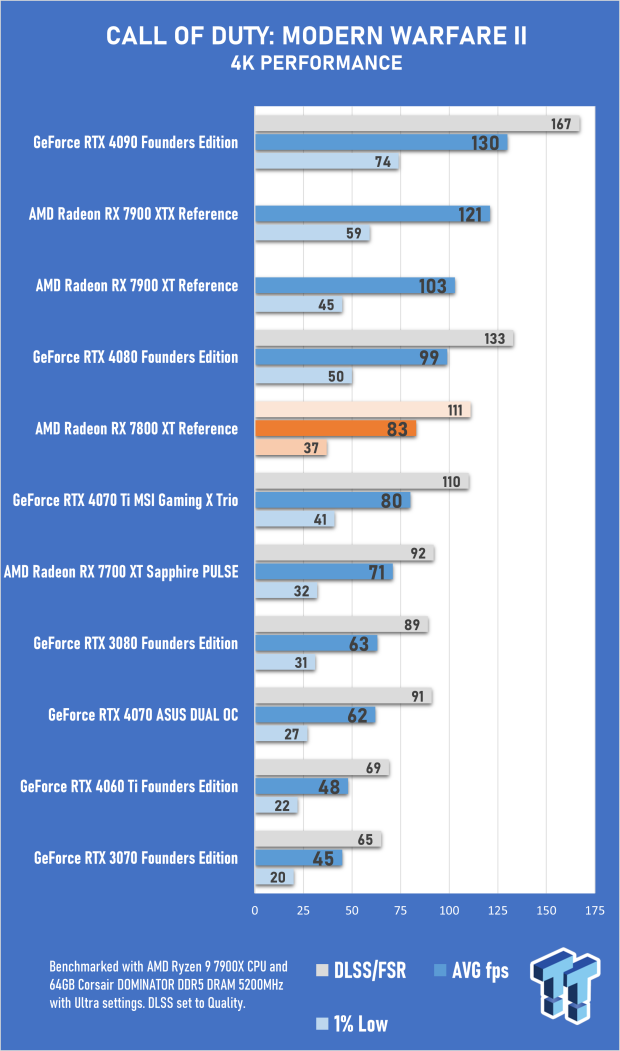
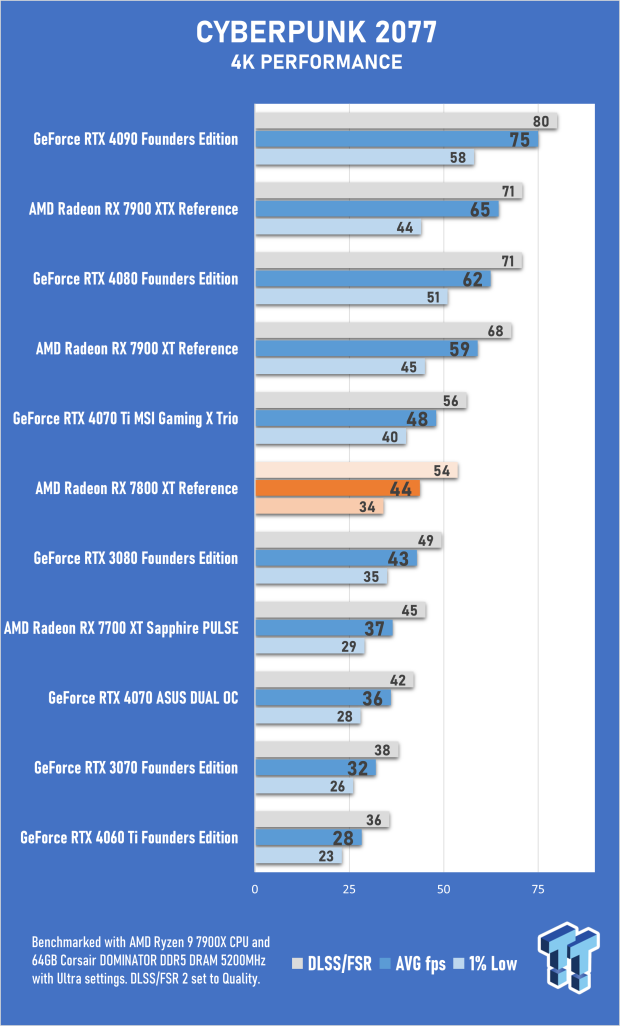
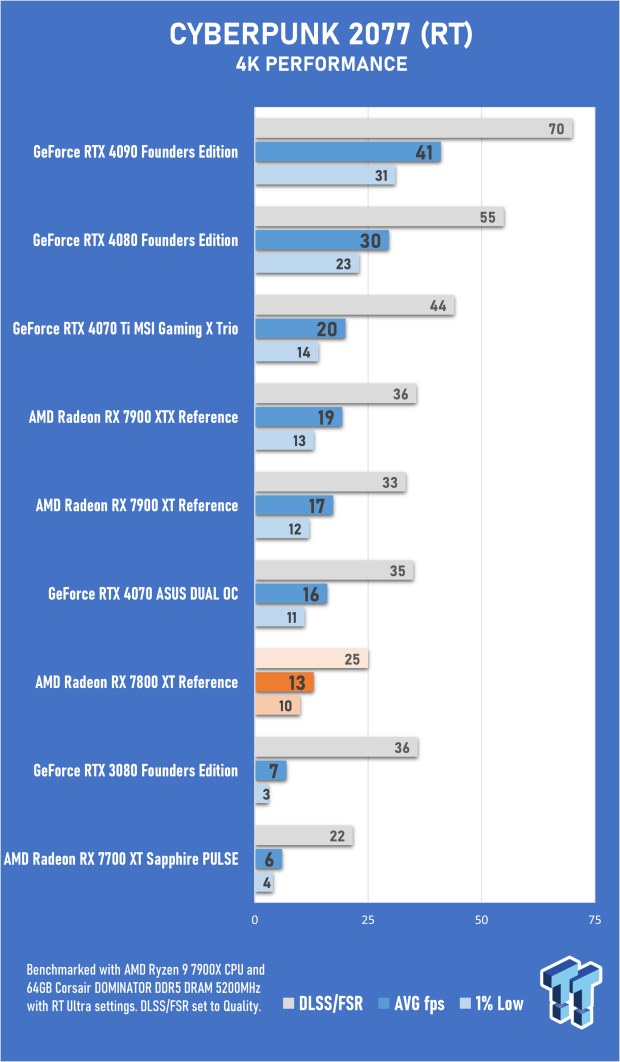
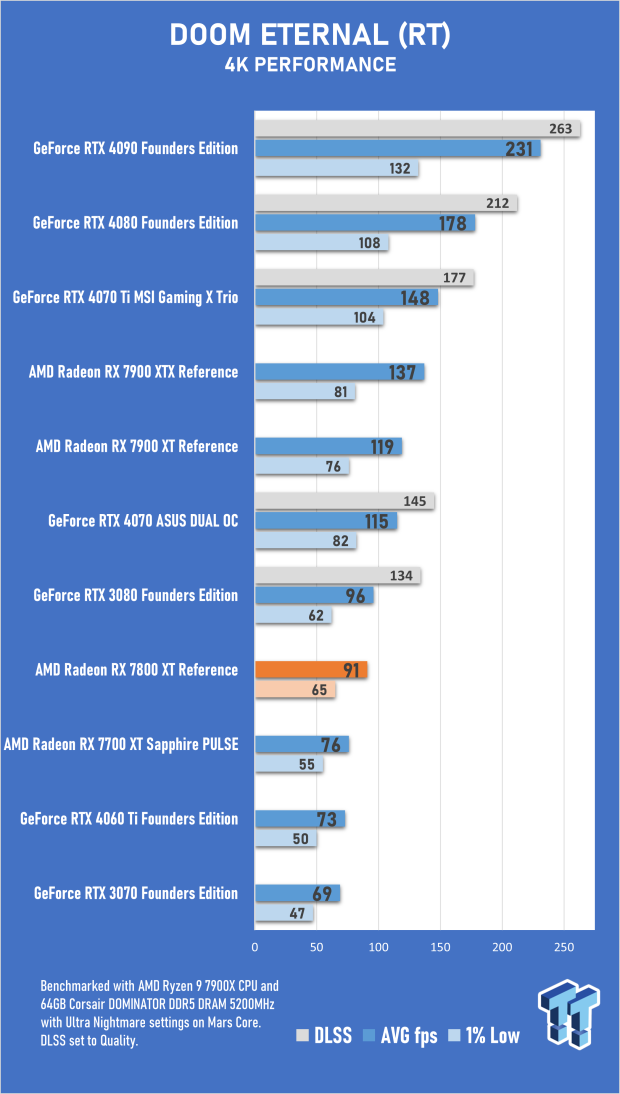
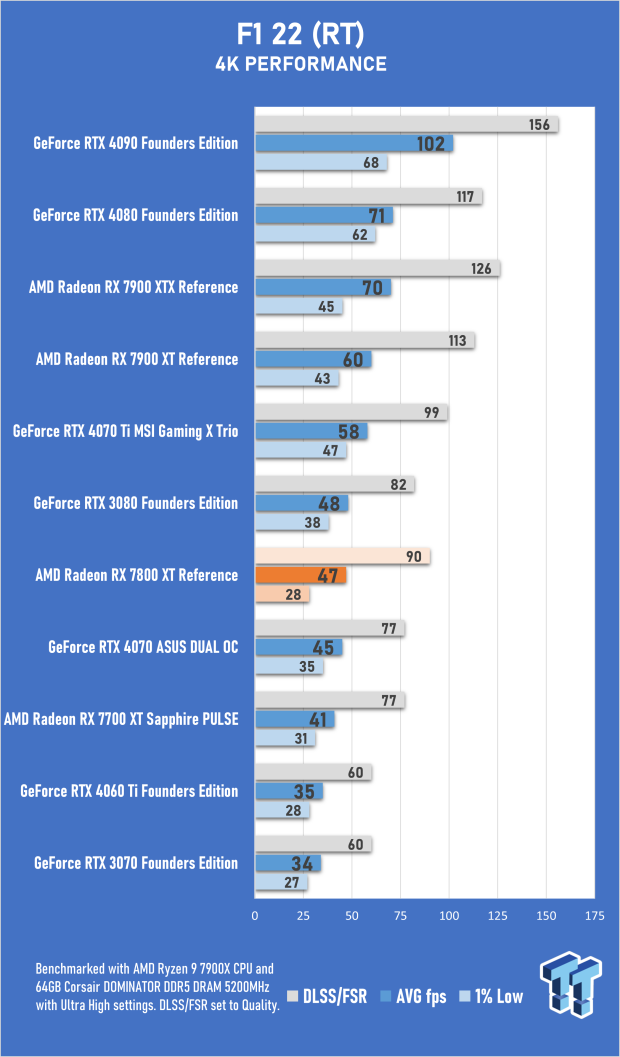
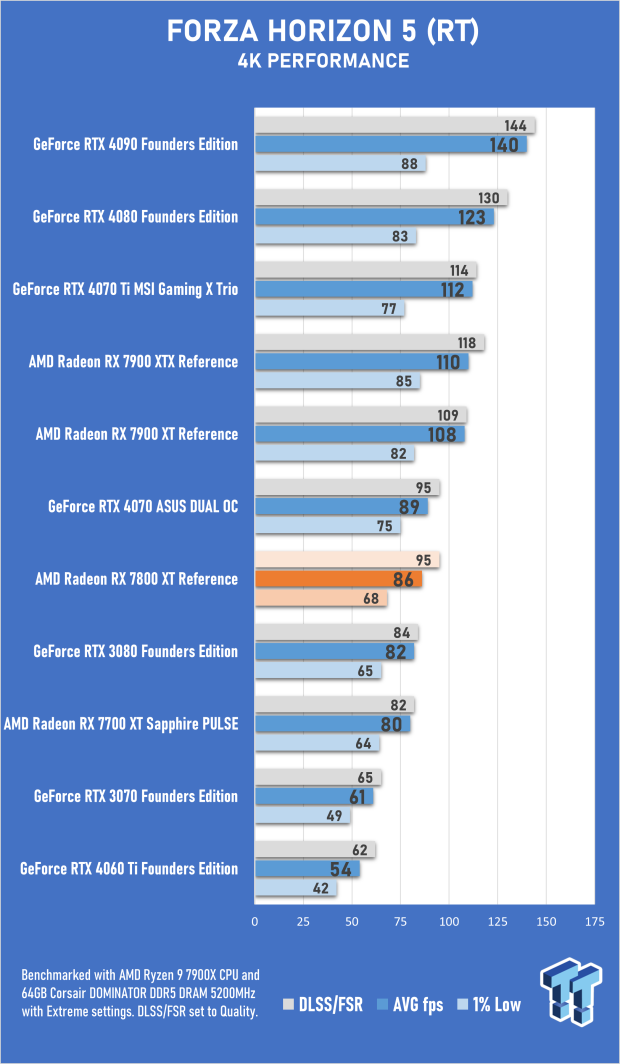
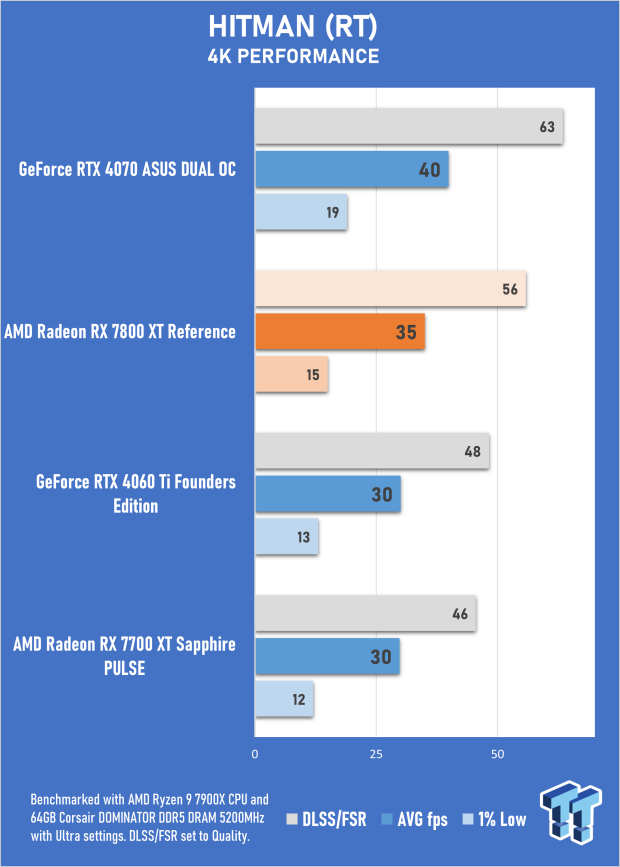
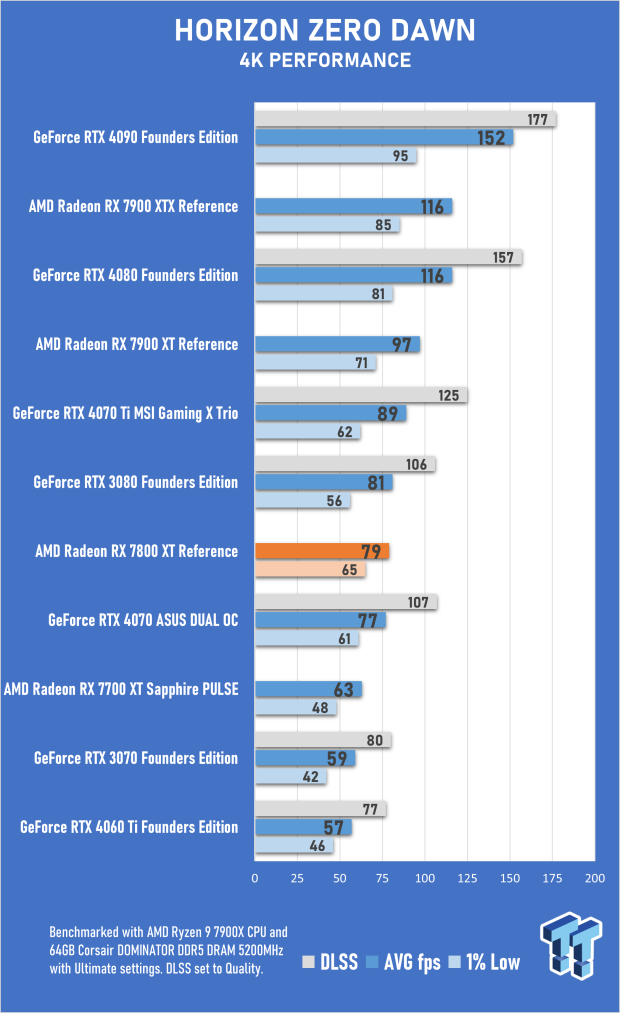
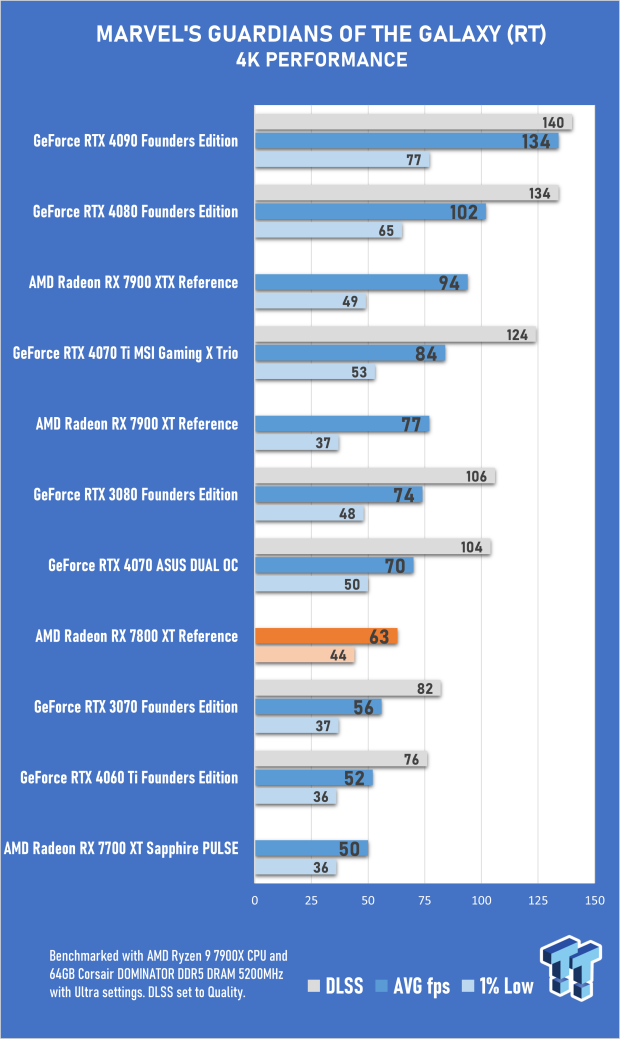
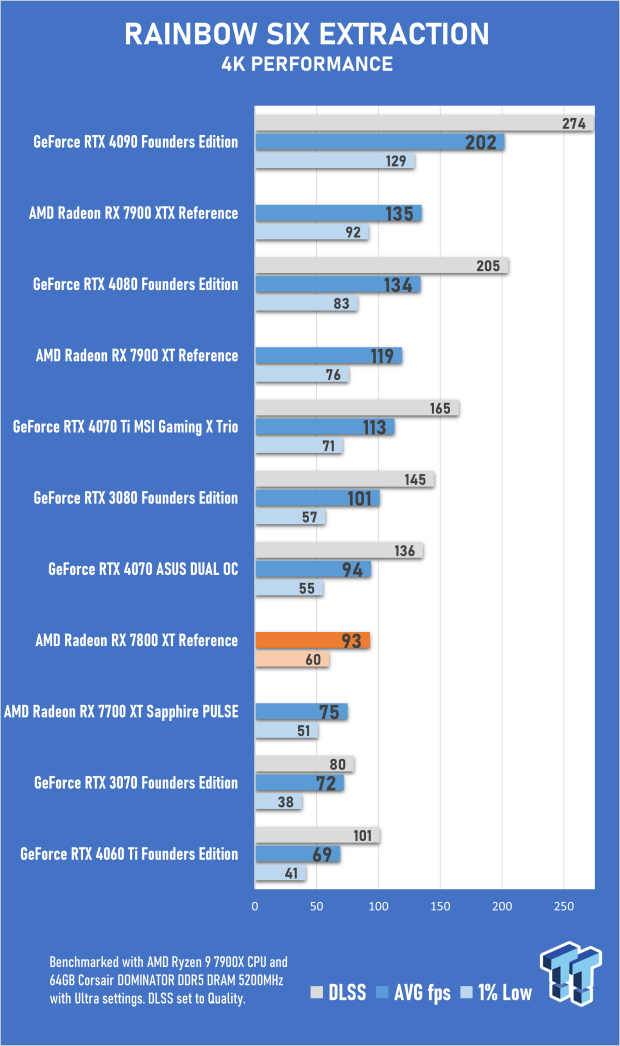
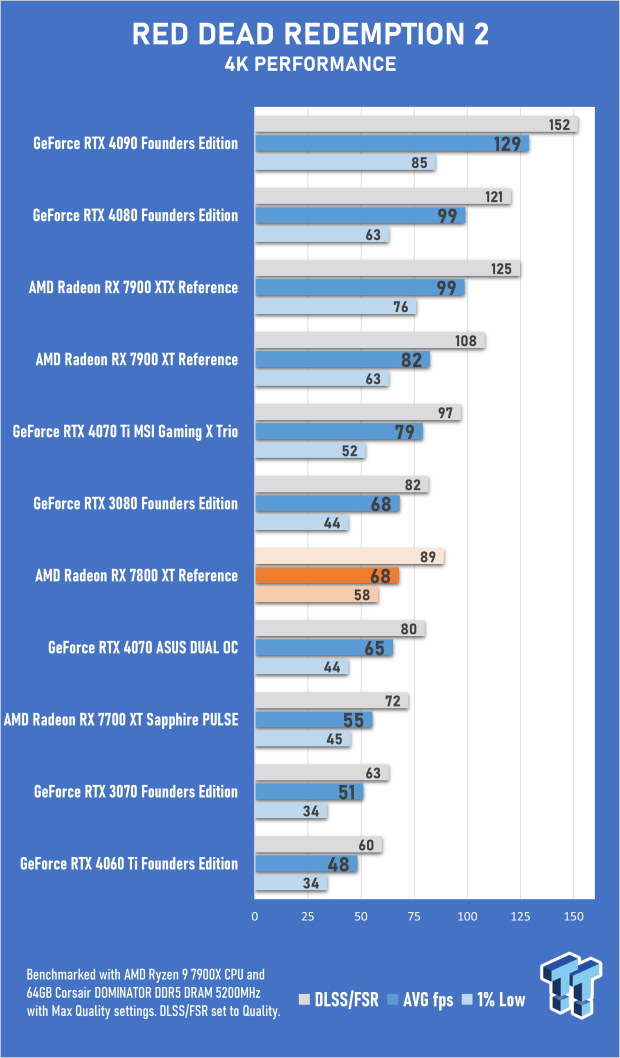
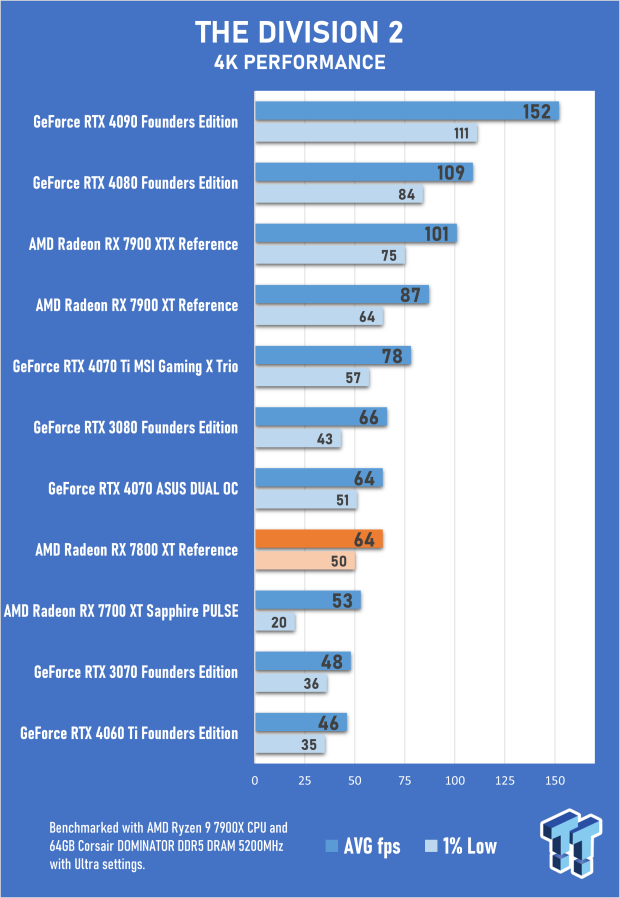
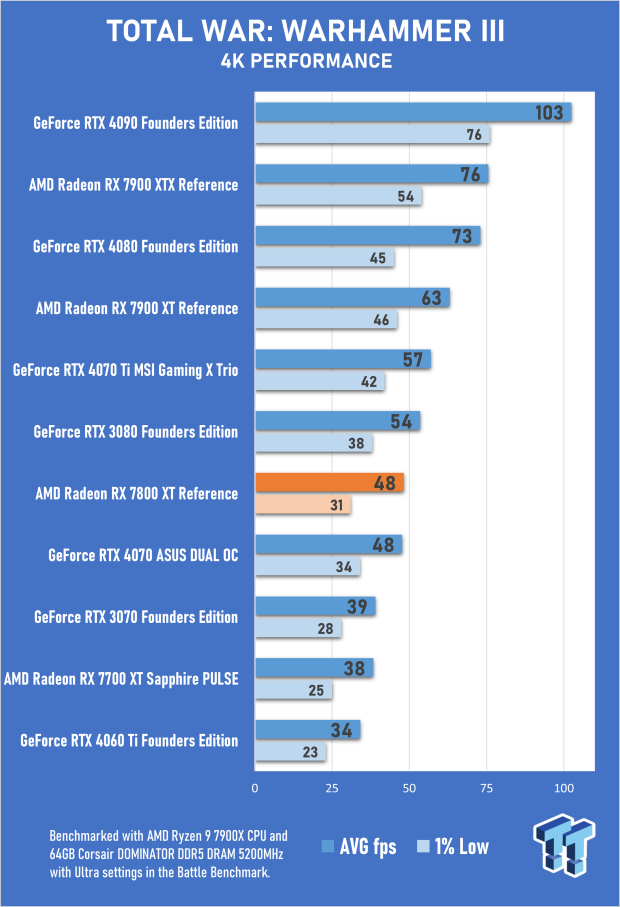
Benchmarks Summary - RT, FSR 2, and FSR 3
Okay, so there's been a lot of comparisons made between the Radeon RX 7800 XT and NVIDIA's GeForce RTX 4070, and this comes down to the fact that AMD has aggressively priced the new GPU to effectively shift the conversation away from how it performs gen-on-gen (i.e., compared to its predecessor the Radeon RX 6800 XT) to where it fits into the current pricing market for brand-new GPUs. This is not to say that this is intentional, but certainly, it's the context one needs to factor in when looking at GPUs in the USD 499 or so price range.
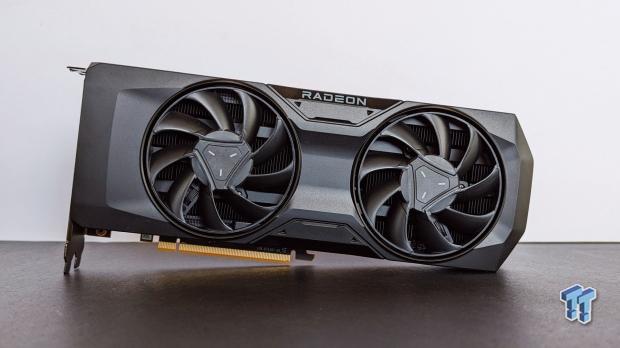
Even though there's a give and take between GPUs in this range, especially the GeForce RTX 4070, AMD is still behind when it comes to overall ray-tracing performance, and at 1440p (where the 7800 XT shines) AMD's FSR 2 upscaling delivers noticeably worse image quality than NVIDIA DLSS - especially when looking at distant objects while moving.
Also, it's a shame that FSR 3 and AMD's Fluid Motion Frames were not made available to reviewers in time for the 7800 XT and 7700 XT launch - as DLSS 3 Frame Generation is a game changer in many titles - especially RT-heavy ones. But, again, with the context of its USD 499 MSRP, it's hard to deny just how enticing the Radeon RX 7800 XT becomes when looking at the full range of new GPUs on offer from Team Red and Team Green (we'll have to wait until next year to see what Intel is cooking up for its next-gen Arc).
Temperature and Power Efficiency
Even though the Radeon RX 7800 XT is more power efficient than the Radeon RX 6800 XT, this is still one area where AMD has taken a back seat to NVIDIA. If, on average, the Radeon RX 7800 XT performs on par with the GeForce RTX 4070 - then it does so by using roughly 30% more power when under load, plus an increased idle power usage of 30-40 Watts, it's generally sucking up more juice than its GeForce competitor.
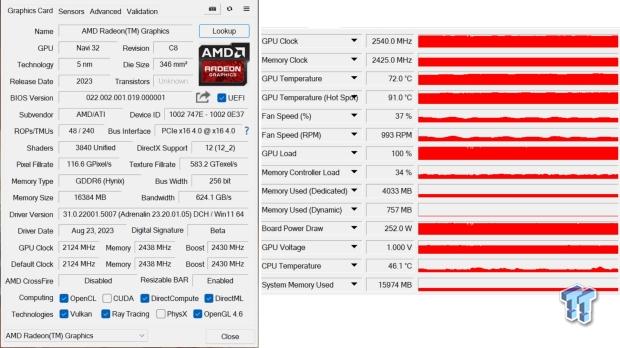
With a temperature of 72 degrees and a hot spot temperature of 91 degrees, AMD's reference 7800 XT certainly runs warmer than other models and variants. The idle temps stay above 50, too, so it's generally a warm card no matter what's happening. As mentioned earlier, if you're conscious about overall temps, then definitely stay tuned for our full reviews of the Sapphire NITRO+ AMD Radeon RX 7800 XT Gaming OC and ASRock Radeon RX 7800 XT Phantom Gaming OC graphics cards. Otherwise, the solid metal build and physical design of the reference 7800 XT are excellent.
Final Thoughts and Starfield
The Radeon RX 7800 XT is here, and the result is very different from what we would have predicted - a card that presents a generation leap in performance and efficiency over the Radeon RX 6800 XT. Instead, you're looking at a more modest improvement with the added benefit of RDNA 3 technologies and features that extend to content creation (hardware-based AV1 encoding) and improved ray-tracing. That said, the real impressions start to form when you factor in the USD 499 price point, making it a competitive alternative to the GeForce RTX 4070, with the bonus of a free copy of Starfield on PC when you buy one.
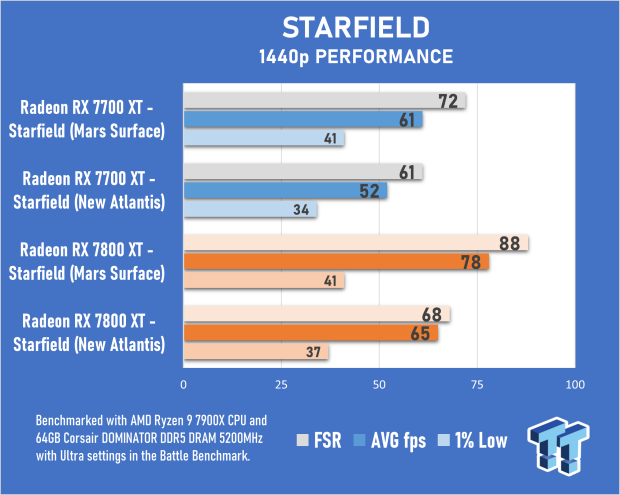
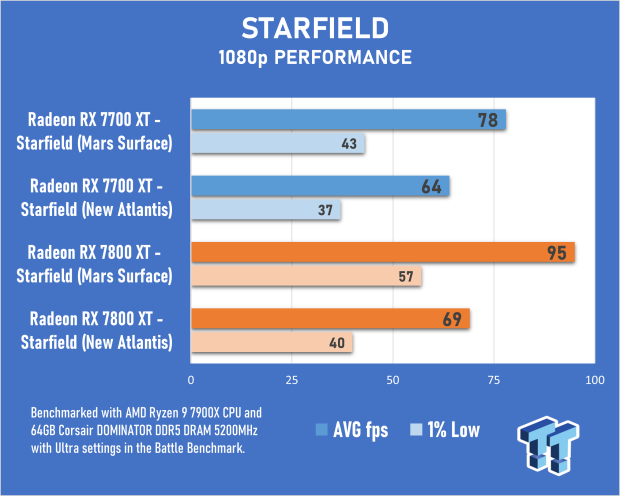
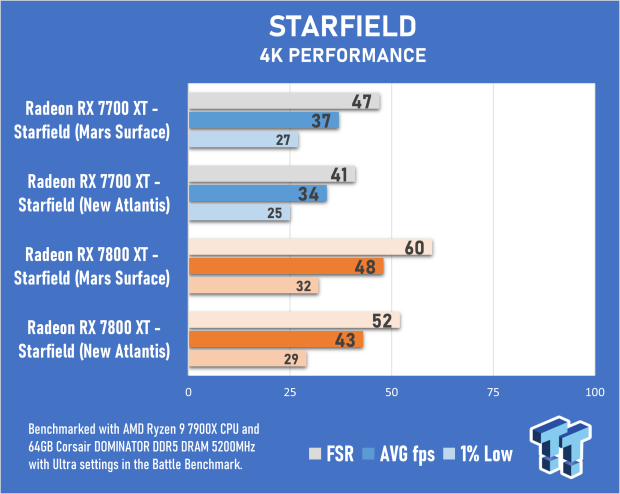
Starfield is a PC killer in many ways, in that running the game with Ultra settings requires a lot of CPU and GPU grunt. Here, we can see that the Radeon RX 7800 XT has no issues running the game at 1440p - even without FSR 2. Even though FSR 2 still feels a step behind DLSS in terms of visual fidelity and features, the upcoming release of FSR 3 and AMD Fluid Motion Frames should add a feather to the cap of the 7800 XT. Assuming, of course, that image quality and latency are on par with DLSS 3 Frame Generation.
Even though some Radeon technologies like FSR still have room to improve, alongside overall ray-tracing performance for RDNA, the AMD Radeon RX 7800 XT still feels like an exciting 2023 GPU release. It adds a healthy dose of competition to the mid-range and enthusiast GPU market. USD 499 is a commendable price point, especially when you throw in excellent 1440p results.

